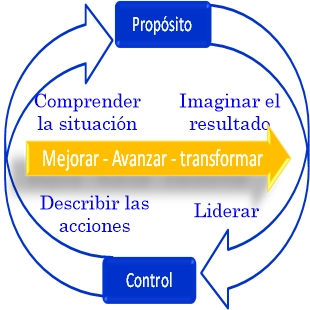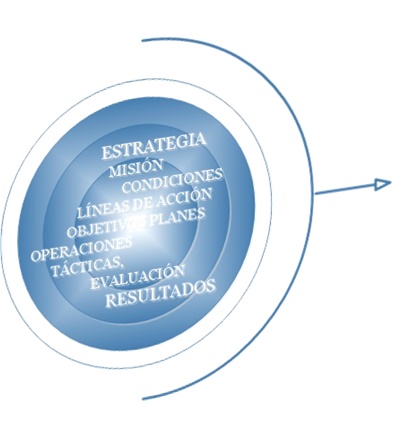

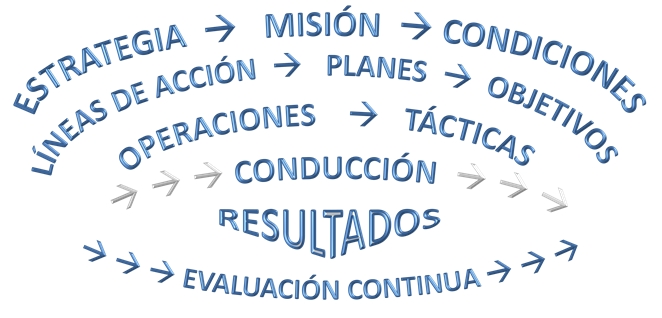
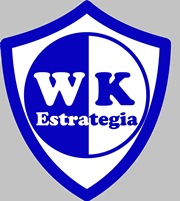


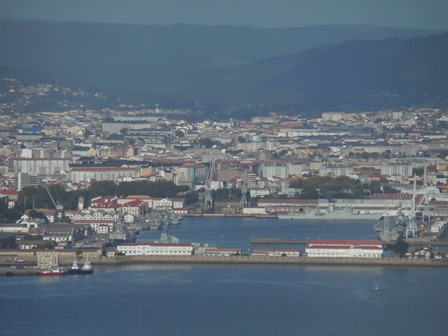
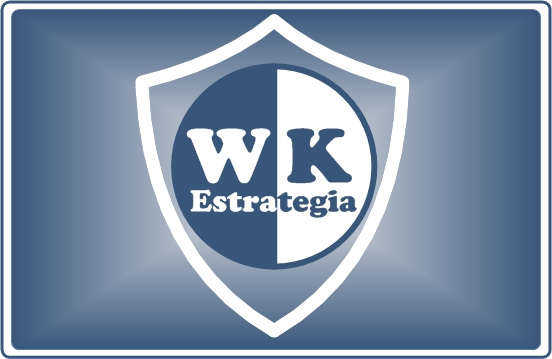
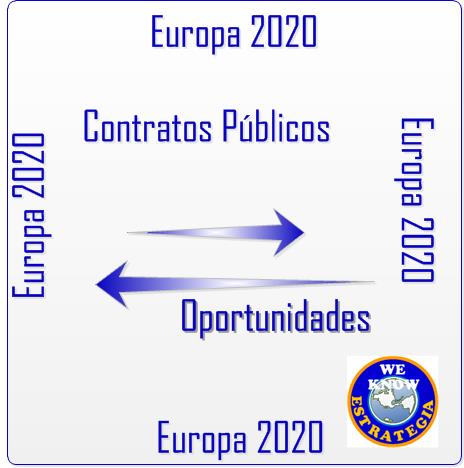
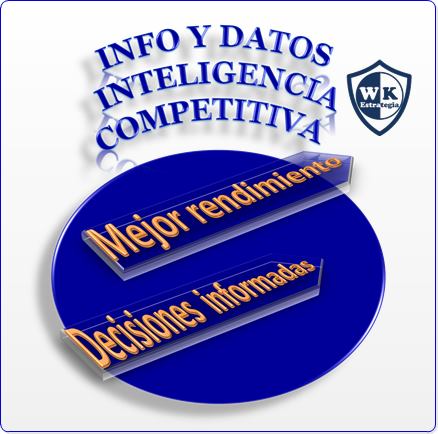

Overview
For many businesses, growth may be a good thing, but what is essential for everyone is to improve daily, every day, in pursuit of their purpose.
Transformation
Transformation is essential for any organization in order to become skilled to meet and face different challenges from the coming opportunities.
Strategic Management
Strategic planning has a creative approach which is essential for the smooth starting, running and sound growing of the business.
Learning in Progress
We help you to go beyond superficial knowledge to deep knowledge, i.e. from knowing how things are done to find out why they happen and to ask if are there any better way to do them.
Management Control
The management control (MC) is the necessary discipline to implement strategic formulation of yours organization.
Operations Management
The primary objective of operations management is to serve the clients utilizing organization's resources to provide the right thing, at the right price, at the right place and at the right time. The second objective is to use all these resources in an effective and efficient way.
Project Management
Any organization needs to employ the project management methodology to pursue more effectively and efficiently than competitors its vision goals and fulfill its mission. We can help your organization following the Project Management Institute methodology
Competitive Bidding & Internationalization
To successfully participate in public tenders, the entire process should be known from the beginning and covering all stages
European Union 2020
Europe 2020 strategy has three mutually reinforcing priorities: such is to become a smart, sustainable and inclusive economy in order to deliver more employment, more productivity and greater social cohesion. But also provides many opportunities for small and medium sized enterprises.
Competitive intelligence
Competitive intelligence is crucial for all organization’s operations, and doesn´t have to be related to secret: Once is obtained it must be shared within the organization and with partners, but also must be protected
SME's
SME's must face specific challenges in regard with three different stages in their lifecycle: Start, Run And Grow.
Capabilities
Comprehensive approach.
Capabilities are based on spontaneous patterns of interaction and somehow they are of difficult understanding to be managed in a executive sense.
Structure. Capabilities development, either internally or externally, need flexible structures based on three pillars:
- Teams
- projects
- processes
Experience. Our approach emphasizes that lessons learned from experience, show that effective management needs a comprehensive approach in which every organization, although having parts is also part of a whole, not only involving different performers such as suppliers, customers, strategic partners, competitors, public administration, society…, but also good timing of actions to do.
Spans to a wide community. Our comprehensive approach does not begin and ends inside an specific organization but spans to a wide community of performers who are involved with it while looking for its goals.
Indeed, in our changing and almost unpredictable world, organizations have to meet many complex challenges, and the means they have, very often, are not enough on their own, so that, strategic alliances with other organizations are needed. In this context, and taking into account their respective strengths, as well as their own decision-making process, effective implementation of a comprehensive (which does not mean exhaustive) approach requires all performers to contribute to same goal through dialog and exchanges, in a framework established by an agreement –tacit or explicit- based on a shared understanding of responsibility, goals, honesty, openness and resolution, both internally and with partners.
Results are outside. The Effects Based Approach is necessary, and represents the need for deliberate planning and action in business management to maintain the greater unity of effort and resources.
CONTACT:
If you need more information about what WK Estrategia can do to help you, please send us an e-mail to info@wkestrategia.es, or click on "contact" in lower side of this web site
Change is the only thing that is constant in our current environment. We help you to take advantage of it.
Our proposal to carry out the transformation process is based KOTTER's methodology. Changes are made for a reason after making the most effective decision in order to get the right commitment. This usually leads to the conclusion that maintaining the status quo will only set the stage for another crisis instead of achieving a better position.
Transformation is a process that is not quick nor easy, because what actually have to change are the people, their behaviour and their commitments, it is not the organization. What actually has to change is the status quo and it is really a hard work.
Our focus is on these 8 steps as the most critical to have in mind. We know they are not the only ones, but we do know they are the stones on the road where many organizations have bumped.
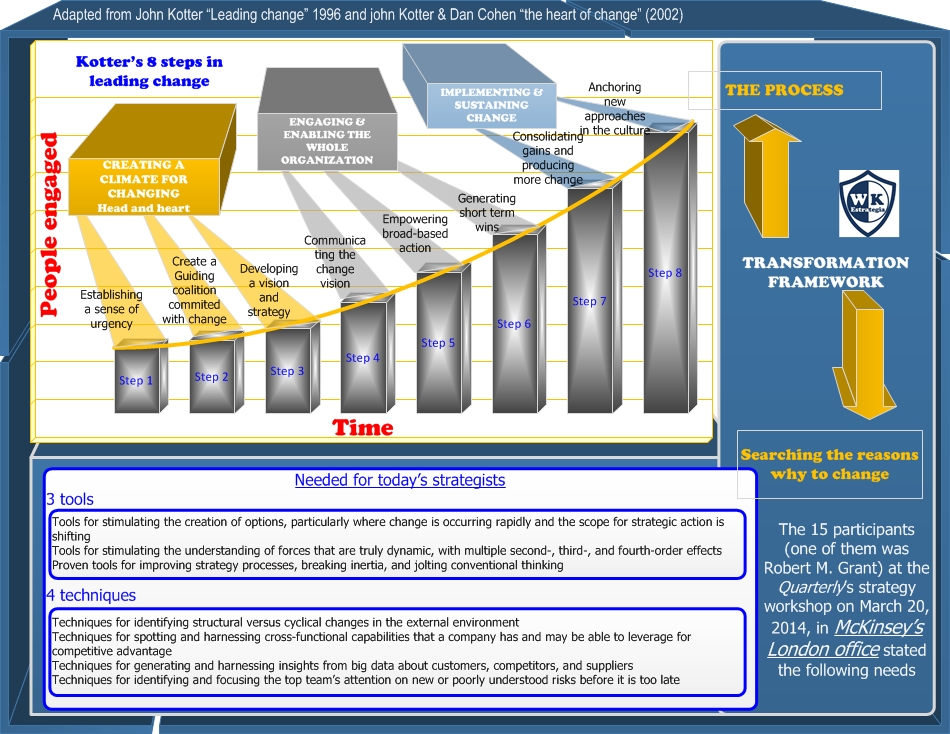
CONTACT:
If you need more information about what WK Estrategia can do to help you, please send us an e-mail to info@wkestrategia.es, or click on "contact" in lower side of this web site
Porter in 1987 proposed a breakdown of the company's core activities to carry out its mission of providing goods or services in exchange for benefits. This model helps to find out where the sources of competitive advantage are:
· In its primary activities or support?
· In the influences and dependencies between these activities, ie those called by Porter horizontal links?
· In relations with other external actors, or as Porter said, in the vertical links
· In all interlinked?
Identifying the sources of competitive advantage is an ongoing and continuous process, since not a day passes without new challenges that force to adapt, or what is the same to "transform" to address threats and seize opportunities.
Transformation is a long haul task. Requires to articulate and manage the ability to look ahead anticipating the effects that will occur keeping on track common high level goals for all while flexibility as much as possible is maintained.
A critical factor is the information system ... // interoperability // strategic alliances

CONTACT:
If you need more information about what WK Estrategia can do to help you, please send us an e-mail to info@wkestrategia.es, or click on "contact" in lower side of this web site
Resources & Capabilities Analysis. WK Estrategia Methodology
The links between resources and capabilities of an organization need attention and thought to make effective decisions that reach the right compromise and run with resolution. Some authors have defined organizational routines and capabilities as complex patterns of coordination (and cooperation) that allow several specialists integrate their knowledge to provide goods or services while maintaining the efficiency of knowledge specialization1.
Along with this definition, we believe that capabilities2 are a set of factors balanced in various ways and whose components are:
- 1) Doctrine, which are the basic principles that guide the implementation of all activities and coordinated towards a common goal;
- 2) Organization, which enables individuals and services the systematic cooperation to perform their tasks;
- 3) Training;
- 4) Assets other than infrastructure;
- 5) Leadership and Education;
- 6) Personnel with appropriate qualifications and commitment;
- 7) infrastructure.
Our methodology3 has four steps, first and second use objective rationale, third and fourth steps use subjective rationale to figure out conclusions.
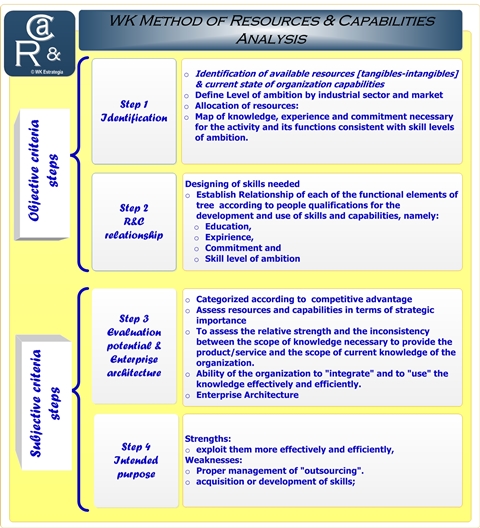
1 -Nelson y Winter, 1982-
2 OTAN
3 Adapted from Robert M. Grant. Capabilities and resource based view
CONTACT:
If you need more information about what WK Estrategia can do to help you, please send us an e-mail to info@wkestrategia.es, or click on "contact" in lower side of this web site
Strategic Alliances.
The number of strategic alliances is growing in the current environment, where flexibility and resilience are required.
In WK strategy we can help the components of a partnership to develop the ability to:
- Clarify and establish the definitions of each key concept deployed and the relevant hierarchy in the set.
- Develop close relationships with their customers and other industries within their sector or outside of it. Surely a number of concessions should be made in either direction, but the expertise is still important in transaction costs.
- Use open standards wherever possible.
- Effective using of the following means:
- On the job training along with allied partners
- Rehearsals
- Lessons Learned
- Experiments with new approaches operating as an alliance
- Incremental improvements
Partnerships are more necessary in times of instability, because organizations must face many complex challenges, and very often the means at their disposal are not enough to fend for themselves.
In WK Strategy we are clear focused on results and the growing importance of strategic planning process and its corresponding actions and consequences in order to maintain the greatest possible unity of effort and concentration in the utilization of resources.
One of the reasons for promoting strategic alliances is to access -rather than acquire- the knowledge that every partner has in order to ensure complementarity exploitation, while each partner keeps, and even develops their distinctive specialization (RM Grant and C . Baden-Fuller "A knowledge accessing theory of strategic alliances").
Acquire knowledge to apply it is slow very often (SECI model and Spiral of knowledge of Nonaka and Takeuchi), and economically is costly along with being risky if organization doesn’t get the same teams who know how to integrate that newly acquired knowledge and ends up for overwhelming the people that perform these activities in the organization.
Moreover, in strategic alliances the decision-making process remains intact in their respective organizations, therefore it is essential to ensure that collaboration amongst partners be smooth, effective and efficient in terms of transaction costs.
Interoperability amongst partners is also essential to do the best with resources pooled by the corresponding alliance.
The real effectiveness of Partnerships, needs that their partners can "interoperate", that is to be able to work together but not mixed in order to achieve the common objectives at different levels.
Interoperability also allows shared use doctrine, experience, services and infrastructure so avoids duplication and creates synergies.
See below for the conceptual model of IDEAS (International Defense Enterprise Architecture Specification).
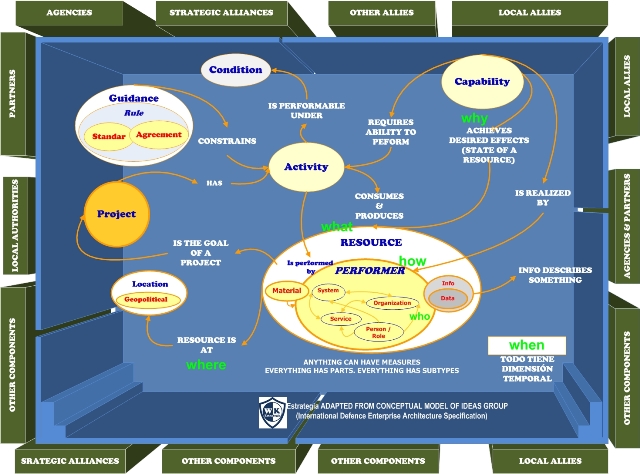
CONTACT:
If you need more information about what WK Estrategia can do to help you, please send us an e-mail to info@wkestrategia.es, or click on "contact" in lower side of this web site
Ad hoc depictions.
See the following depiction of a strategic formulation representing a common structure to articulate two intertwined approaches: thematic and "time-driven" according to the deadlines of the strategic goals.
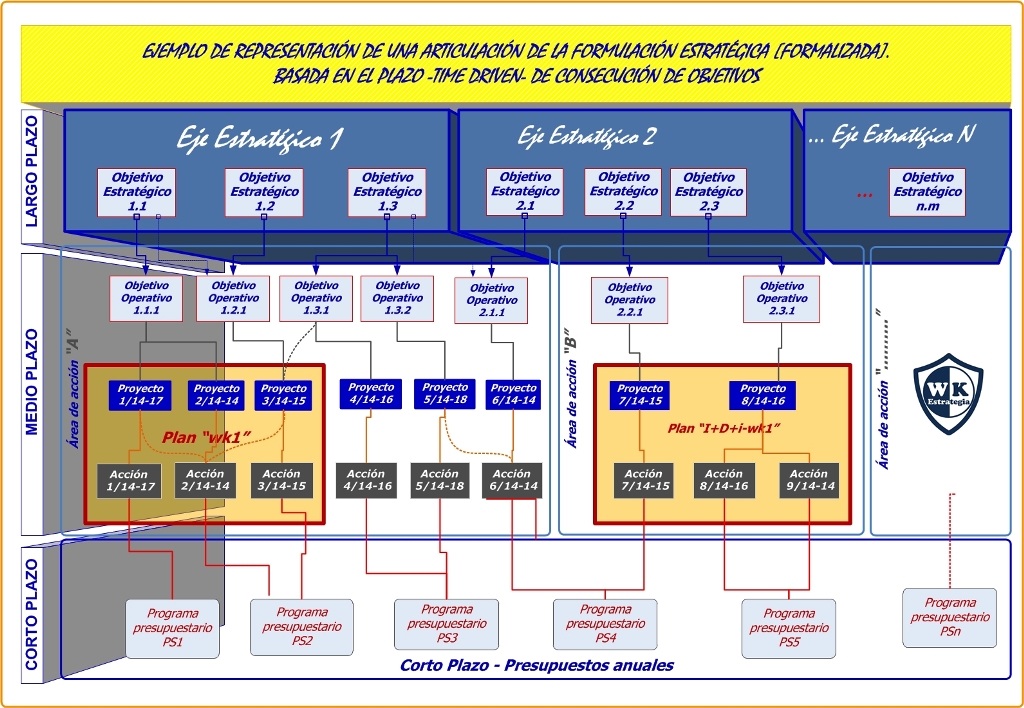
We have various representation designs on which relevant strategic and operational indicators and their respective trend would be positioned.
The Balanced Scorecard is another methodology of representation used as strategic map where objectives and indicators and their trends are placed in one particular perspective of the 4 defined by Kaplan and Norton.
There are many different ways of representing strategy goals and key performance indicators to turn raw data into useful information in order to focus people efforts on achieving the strategic goals and to manage, properly, operations performance. In this tab you can see another model from us (fictitious) about certain capabilities of a regional health Authority. The objectives placed on it are referred to specific geographical locations and based on certain capabilities key performance indicators lined up with strategic formulation at a given time.
In WK Estrategia we know how to make it simple and effective.
CONTACT:
If you need more information about what WK Estrategia can do to help you, please send us an e-mail to info@wkestrategia.es, or click on "contact" in lower side of this web site
Strategic planning questions and answers.
About strategic planning there are these 6 modern answers to 6 ancient questions (from the poem of Rudyard Kipling "I Keep Six Honest Serving Men ..." (The elephant’s child), What, Why, When, and How, Where and Who).
Althoug every organization is unique and thus there are a wide range of strategic planning processes variety among organizations, the answers to these six questions, for the present, are:
What: Every business has a short number of key abilities or distinctive capabilities which make it stronger than their competitors. The process of strategic planning determines the desired goals and ways –actions to perform- to reach them using those key abilities, at the present or developed for the coming years. Strategic planning is not a luxury but a an essential, formal or informal, it depends on size, structure and of course rigor needed.
Why: strategic planning is a continuous and partially unsystematic process, and once you’ve done it (or you believe it), perhaps the harsh reality will bring down many of the statements or predictions, and will call for reaction. But no problem, all the organization had to think about itself, and will have to do again, both internally and externally and continuously. The knowledge that will be acquired if doing the best in planning, will make possible to get a new and a strong distinctive capability, a dynamic one which will provide the organization with versatility and resilience, almost the most important skills to face challenges in actual life and to get a hard to imitate competitive advantage.
When (Frecuency): Need for Strategic planning can emerge anytime. When the environment is stable, the need for predictions, with a few rare exceptions, almost doesn't exist. Obviously our environment is not stable at all. Good timing of actions to do requires the virtue of prudence, so the greater uncertainty the shorter planning period revision frecuency, especially in markets with high levels of innovation. Unfortunately, many of the named strategic decisions are only band-aids that fail to add long-term value. They are neither strategic nor decisions, but only reactions forced by caprice of circumstances.
Where (organizational levels in and outside): on the one hand environmental instability is a powerful driver to decentralize strategic decision-making due to needs for speed, versatility and resilience. On the other hand, in strategic alliances, very fashionable today, few organizations wish to be coordinated by another. In fact, in business world, regular consultation rather than endeavoring to nominate a single performer to be leader in managing is the realistic way ahead. The appropriateness of this answer needs to find a balance between decentralization and centralization.
How: flexibility and formality of planning processes are inversely proportionated, while need for detailed plans not only remains but grows to meet challenges successfully by means of tougher planning efforts. Nowadays exists a need for speed or in other words, less bureaucracy and more versatility is required. Technology helps in this: to send a report to any place and to any one while it lives in the cloud doesn’t require neither extra effort nor extra time.
Who: top-down & bottom-up. If the strategy looks for results in a given period, anyone who must be informed or has to inform about some specific area of performance, must participate and of course be invited to. The effective implementation of one normal strategy is better than to have an extraordinary one in staff archives.
CONTACT:
If you need more information about what WK Estrategia can do to help you, please send us an e-mail to info@wkestrategia.es, or click on "contact" in lower side of this web site
We see the strategic process in this way.
A clear strategy (either designed or emergent, or both) which is properly executed, leads organizations to outperform.
Besides this, creating a compelling strategic formulation and of course communicating it throughout the organization top-down and bottom-up, it's the way forward to success.
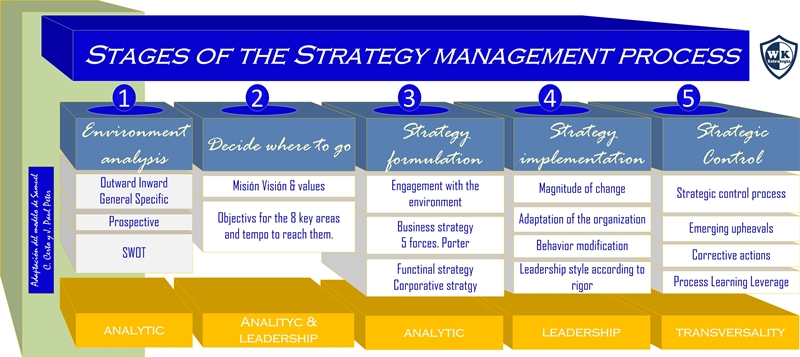
Maturation stages to design and implement, within an organization, an appropriate system for strategic management.
The first thing to note is that there is a "sine qua nom" condition which is to accept this system is not improvised but requires time, serious thought, tenacity, commitment and above all, leadership.
Until an organization has and implement its own system goes through four stages of maturation of the project (Samuel C. Certo and J Paul Peter), growing in effectiveness, from the formal planning, and the scope of objectives set in planning. See each.
- Basic Financial Planning focused on meeting the annual budget by the "operations management". The functions are performed without regard to their integration in the various primary and support activities. It suffers from an overview.
- Planning-based prediction. Planning for growth
- Planning with external orientation.
- Strategic management, ie planning to create the future.
The time spent on perfecting the system, if done with resolution and common sense, is surely one of the most productive one for any organization that wants to become and remain a leader.
Graphically we represent these stages as follows:
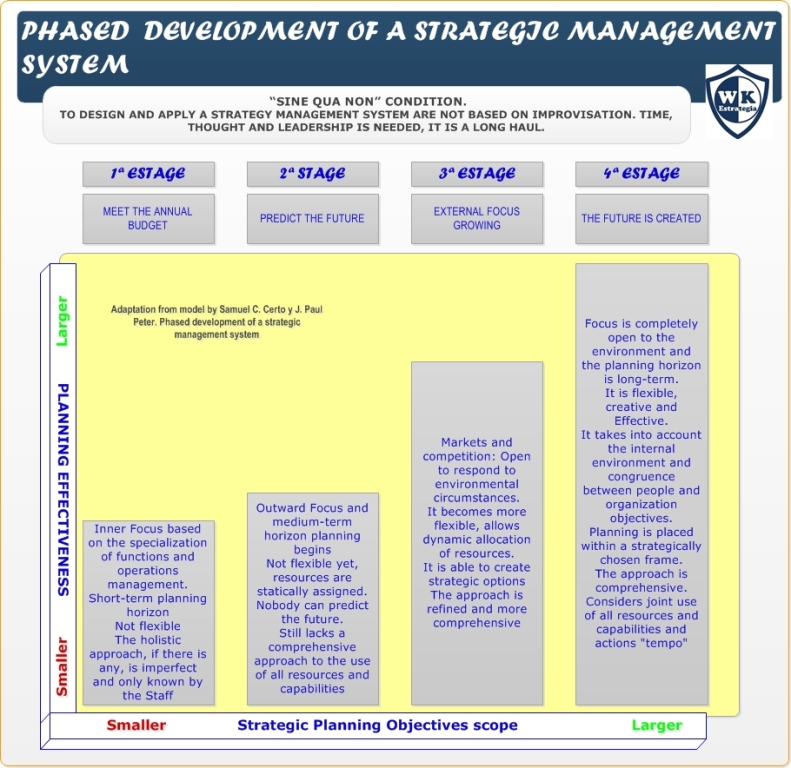
CONTACT:
If you need more information about what WK Estrategia can do to help you, please send us an e-mail to info@wkestrategia.es, or click on "contact" in lower side of this web site
The smooth running of an enterprise. Key approaches
Each organization should first identify its "Strategic Concept", by which defines its core purpose, their durable nature and its core activities, which would be its mission, the reason for being.
Within that concept, environment key factors must also be identified as well as the organization approach, properly articulated, to meet and face the challenges of the environment with the necessary guidelines to be versatile and resilient to seize opportunities and neutralize risks or threats.
We use the term goals to describe the purposes of an organization. They are timeless and have validity until changed.
We use the term objectives as the specific outcomes agreed upon strategic planning, which are measurable, realistic and that should be reached on time (SMART: Specific, Measurable, Agreed upon, Realistic, and Time bound). Objectives are also the Commitment of all components of the organization to achieve the entreprise goals.
Internally we propose the graph model below to help you to identify the components that deserve joint attention with an essentially pragmatic focus on results.
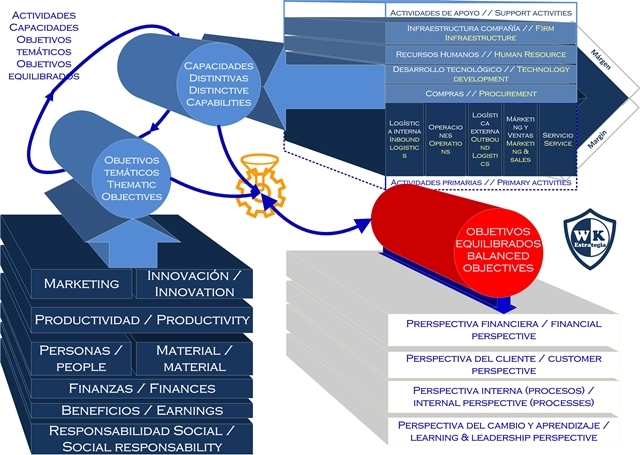
Every organization has a sui generis form of jointly perform all activities of its value chain excelling in certain key competencies which we call distinctive capabilities. Identify them is essential.
Moreover, all companies have 8 key areas and in each of them are set, or should be, certain objectives that can be reached using their current distinctive capabilities or those to be developed in the future. We called them as thematic objectives.
Finally, we believe that the strategy must be effectively communicated in order to obtain the commitment of everyone in the organization, therefore, the representation of the strategic map of results is needed. we are able to use different methodologies, one of which is shown in the graph: the " Balanced Scorecard "by Kaplan and Norton.
CONTACT:
If you need more information about what WK Estrategia can do to help you, please send us an e-mail to info@wkestrategia.es, or click on "contact" in lower side of this web site
Our value proposition in Knowledge Management is to create an organization that learns.
Its practical development is based mainly on David Garvin's proposal; however, as essential theoretical-practical support are the ideas of Peter F. Drucker, on the organization based on the flow of information and the way of organizing with communication as the core; of Chrys Argyris, to eradicate resistance to learning and promote managerial learning. And above all, from the Japanese Takeuchi and Nonaka because it helps to combine Eastern and Western proposals.
Improving always implies learning something new first, and organizational learning is knowing how to create and take advantage of what has been learned before competitors or adversaries. Processing data, converting it into information, and then knowledge does not arrive, the key is to be able to "take advantage" of it in time, adapting behaviors according to new ideas. It is about moving from superficial to deep knowledge, from knowing how things are done to knowing why they happen and finding better ways to achieve the purpose of the company. This is and will be the most secure and lasting source of competitive advantage.
It is not easy, above all for two reasons: first, because it can arise anywhere in the organization (or in alliances with others) or outside of it and at any level; the second, because each person internalizes in their own, very particular way, the ideas of others.
Our way to understand knowledge management doesn't have continuous improvement as the core focus... surprised?
Yes, our focus is centered on a firm commitment to learning, Continuous improvement will be necessarily its consequence and the leading driver for better results. It's a subtle but crucial difference, because a firm commitment to learning is the soundest basis for creating a learning organization and to improve is necessary first to learn something new.
The scope of our value proposition covers the following areas:
- The Strategic Process.
- Effective implementation of strategic
- Management Control
- Effective communication strategy, techniques and tools
- Interoperability between strategic allies
- Create and track strategic Maps
- Thematic focused
- Multifaceted focused
- Scorecard
- Others
- Readiness Management and Control Operations
- Marketing
- Productivity and process management
- Organizational transformation
- Innovation.
- Management Specializations:
- Public procurement
- overseas competitive bidding
- Europe 2020
- Project Management
In WK strategy we use that model updated in 2003 to systematize the creation, integration and exploitation of knowledge and shown below: 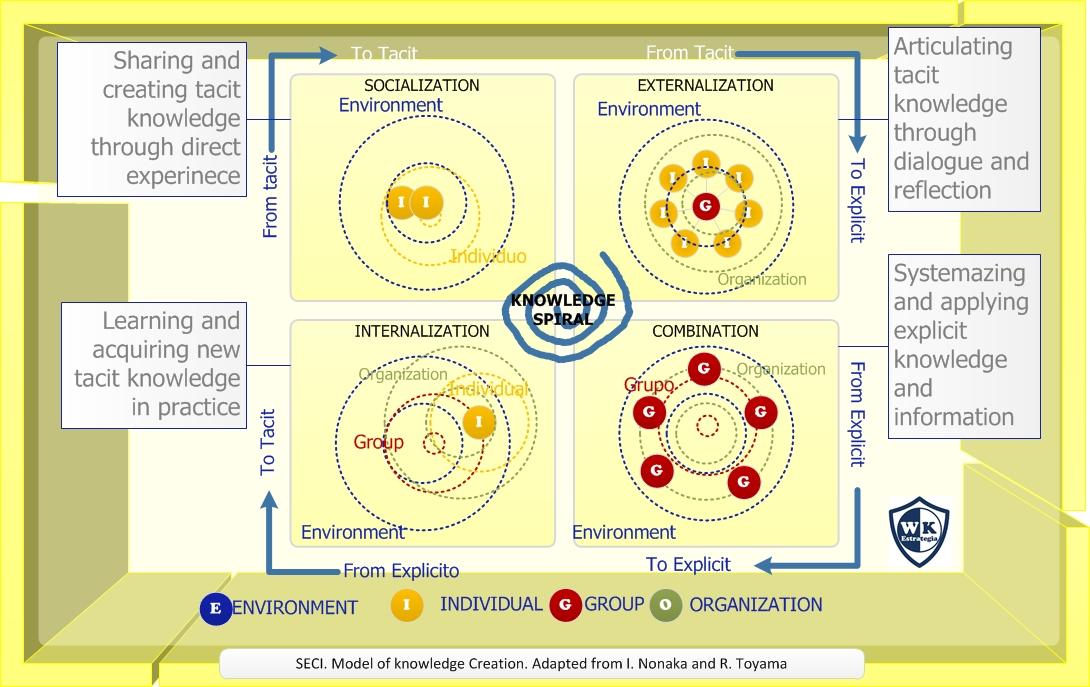
CONTACT:
If you need more information about what WK Estrategia can do to help you, please send us an e-mail to info@wkestrategia.es, or click on "contact" in lower side of this web site
Only spanish version available here.
CONTACT:
If you need more information about what WK Estrategia can do to help you, please send us an e-mail to info@wkestrategia.es, or click on "contact" in lower side of this web site
Under construction.
Where is Management Control in our Capability Map?
Management control is used to successfully implement the strategic formulation, while operations Management is responsible for matching supply with demand.
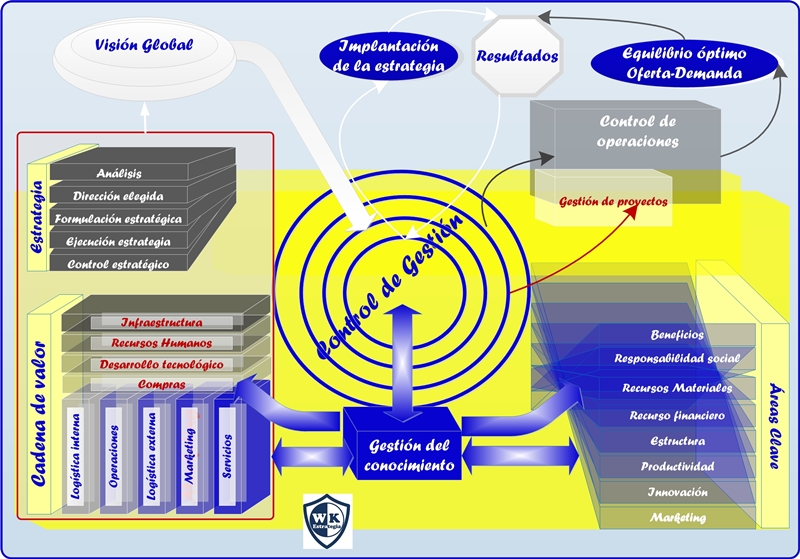
CONTACT:
If you need more information about what WK Estrategia can do to help you, please send us an e-mail to info@wkestrategia.es, or click on "contact" in lower side of this web site
MARKETING:
What makes real a business is the client that it serves. It is not anything else; not its legal registration or deeds; not being adequately resourced or being promoted on all social networks, not even open the door every day. Only the client makes the organization becomes real when purchasing goods or services. The customer is the genesis of a successful business.
The marketing cycle begins and ends back with the customer. But success does not allow accommodating attitudes. New circumstances have appeared precisely due to this success, and will cause that prior performance objectives be outdated.
See below our marketing process model we offer:
(only spanish version available)
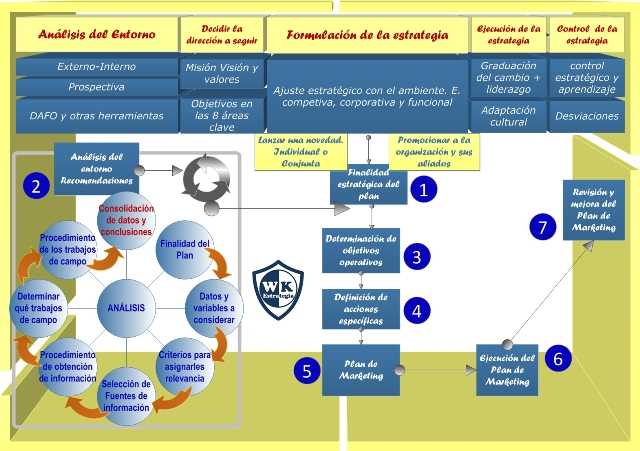
There are some simple questions to pay attention if you want to succeed.
- Who is the customer?
- Where is he?
- What do they buy and why do they do it?
- Who are our competitors?
We have a comprehensive approach: the purpose of marketing is to identify and understand the preferences of customers regarding their needs, desires and values and serve them more effectively and more efficiently than our competitors, searching for the balance between the benefit of the organization and the net utility expected by the client, or what is the same, to create value for him. This is the best source to gain competitive advantage.
There are more approaches. Marketing production approach mainly seek efficiency in production and distribution, but this, sometimes, makes to lose of sight the essential view, which is that of the client. Another aggressive approach is to strain demand through intensive promotion and selling efforts. This turns sale an end in itself rather than being a means.
No disdain at all cost efficiency, it is an advantage that allows, an unknown company, enter swiftly and forcefully be positioned in a market, but as long as the customer is considered as the center of all attention. The customer is interested on those costs whose money shall pay as price, ie the entire economic chain, whether or not of different legal entities. It's not just the cost of the steel mills, distributors, assemblers, etc. Customer what matters is not who does what and how much does it cost. He is interested in the cost of having a car at the door of his house and to use it without problems.
To develop strategies that help to achieve business goals, you must understand your market and identify and analyze your strengths, weaknesses, customers and competitors. Management of customer relationships (CRM) is essential to the success of long-term sales aimed both attract new customers and meet optimally the relationship with existing ones.
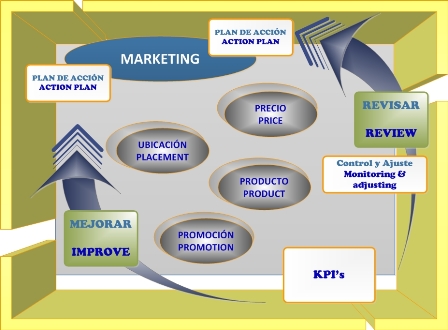
To put marketing as the main function of any business, in the sense expressed herein, has proven to be the direction that provides superior results which means higher levels of customer satisfaction, a goal that we consider strategic and fundamental.
Marketing is a key area for any business and its results should be consistent with corporate, competitive and functional results of the company and, where appropriate, those from the components of strategic alliances. Marketing objectives are not apart from strategic formulation, but is an essential part of it.
Nevertheless, while executing plans, objectives may change, and in fact they do, and often much more than desired. The objectives set the direction in which to go, but not the destination to reach whatever happens. They represent the commitment to achieve the envisioned future of the company.
CONTACT:
If you need more information about what WK Estrategia can do to help you, please send us an e-mail to info@wkestrategia.es, or click on "contact" in lower side of this web site
There are not perennial structures nor a "only one appropriate organization":
It is essential for all organization's components, its allies and partners, to act in a coordinated way and to use different instruments with a mind-set of unity of effort in the utilization of resources, common goals and fair play.
People are organized to provide goods or services of diverse nature, either as employees or volunteers in NGOs; but not to be working as the only reason for being. A university exists or should exist, depending on students whose desire is to be prepared to perform their eventual job and be responsible for it.
There is not either one right organization. The address (or management) of an institution, whatever the nature of this and its life cycle, is responsible for making productive resources in an organized and committed to common goals and values."Without this commitment, no institution, there is only one gang There are three important tasks that must be performed to address the institution responsible work. Peter F. Drucker.
- Reach its specific purpose and fulfill its mission
- Making less hard and smarter work and that people who do it, improve appropriately their balance between working, proffesional and personal life ambitions
- Manage impacts and social responsibilities"
Human organization of a business requires a purely strategic decision on the structure to be settled in order to achieve strategic goals and operational results; their temporal and geographic dimension; the conditions under which the business is running or will run; skills and competencies that the executors should have; restrictions affecting them, etc.
WK Strategy helps clarify the most appropriate structures and their synchronization using to make resources productive and achieve the desired effects.
The current trend is to have at the same time different structures whose suitability depends on the task, the timing and other considerations we have just mentioned.
Our method is mainly based on the ideas of Peter F. Drucker. It is not about managing the work of individuals, or following managerial fashions, but managing for optimal performance. We believe in the following statements that provide flexible joint structures:
- Effective Communication dictates how to organize,not the means to do it.
- Objectives should be understood as commitments not orders, to achieve unity of effort to mobilize energies and resources
- Structure must be transparent and should be known and understood by all organization´s components and its allies and partners.
- The Authority should be unique to make final decisions and should be proportionate to the the responsability.You can not claim full responsibility to achieve certain ambitious goals while invalidate any maneuverability to achieve them. Or give full authority without any responsibility.
- The proper assignment of authority and responsibility, allows that rules be simple and promote sound commitments to an adequate level of change (radical or incremental) to provide flexibility to the structure
- The existence of one line of authority for every person and eliminating of intermediate layers that are not strictly necessary, eliminates interference and noise in communication.
- Organizations are not homogeneous and can not be organized in the same manner at all times and for all tasks.
- It is essential to have a work Team that is sure to exceed expectations, rather than celebrities and traumatic changes of command.
- The work should be articulated in terms of equipment’s skills, processes and projects.
- Knowledge Workers, want a clear recognition of their work, and need constant challenges to achieve results and see them.
- The structure must be tested constantly to prevent its ineluctable "calcification" even abandoning elements considered as "sacred cows."
- Parallel structures can be powerful tools to initiate change and develop new skills. Communities of practice; reengineering systems; circles of total quality management, etc.
Spanish version available here
CONTACT:
If you need more information about what WK Estrategia can do to help you, please send us an e-mail to info@wkestrategia.es, or click on "contact" in lower side of this web site
WK Estrategia can help you in this key area to improve effectiveness in resources utilization so that a better value for customers will be added.
Productivity is defined in terms of utilization of resources -labor and assets or material and can be measured separately for each input resource -factor productivity- More specifically it could also be defined as the ratio between values of output per work hour to the cost of inputs. Obviously the organization`s overall ratio should be greater than 1 to survive the competition.
Organization’s primary responsibility is to serve their clients' needs or wants being more effective and efficient than their competitors. In the field of operations management this include some strategic choices in regard with four attributes that have to be balanced in order to gain a competitive advantage and of course must be consistent with the overall strategy of the organization. These are:
- Quality
- Cost efficiency
- Dependability (reliability and timely delivery of goods or services)
- Flexibility
Nowadays, most organizations can’t develop the best performance simultaneously in all attributes, by trying to do so, they probably end up doing nothing well. Inevitably, strategic choices in a time-based competition environment must be made.
Productivity is closely driven by quality, technology and profitability, but also regulations and scarcity of some resources could impose constraints; bargaining power, managerial factors and organization's culture could have effects on productivity. There is also an international dimension of productivity in regard with strategic choices about moving to a new and more advanced products and employing more flexible systems to accommodate change rapidly.
It could be improved by:
- Improving process in order to do the most with existing resources
- Improving technology
- Controlling inputs
You can see what a process is in the following figure:
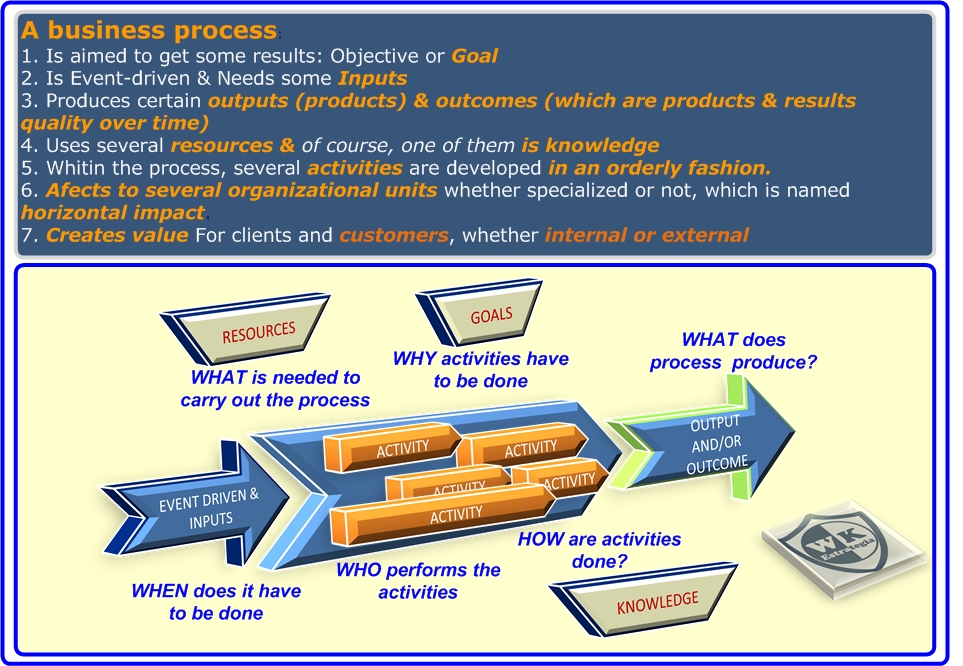
CONTACT:
If you need more information about what WK Estrategia can do to help you, please send us an e-mail to info@wkestrategia.es, or click on "contact" in lower side of this web site
The two faces of innovation.
We think that innovation is a new and original way to match supply with demand, is to say, what customer needs and the solution that creates value for him whilst profit is obtained by the company. Choosing the right price is a key decision that must be made, because the major difficulty is to get the optimal balance between net utility expected by the customer (utility less price) and the benefit that can be reached by the company.
The need for innovate can come from disruptions such as regulatory or technological shifts, demanding new competition rules, or can be forced in downturns to address specific challenges and seize emerging opportunities by reinventing themselves, ie, doing bold moves instead of deploying defensive strategies (whether financial or operational).
An innovation can be small such an incremental improvement, and can be big enough to shift an industry, but rarely creativity from genius is the source of innovation, normally there are innovators to whom creativity visits when they are working. But to avoid that the new idea doesn’t remain only as a brilliant one, it is necessary that the organization develops the “capability” of innovate by means of the systematic analysis, work, and effective decisions in order to guarantee that sufficient support is obtained and properly managed.
The development of this capability requires, in the same proportion, scientific method to develop the concept, and emotional intelligence to identify and understand the signals that can be warnings for action to leverage an opportunity to innovate. The organization must know the theory and practice without gaps between them.
Two paths to innovate:
- Product/Service Innovation
- Business Model Innovation which is especially valuable in times of instability.
Innovation has also two perspectives. One from the customer and the other from inside the organization.
- The first, is based on the value proposition and
- the second on the operating model of the organization to provide the ultimate solution while, at the same time, the company is earning benefits.
Business model Innovation often involves a smart sacrifice that dramatically improve one attribute at the expense of another, possibly even an attribute that is viewed as a “sacred cow” in the industry.
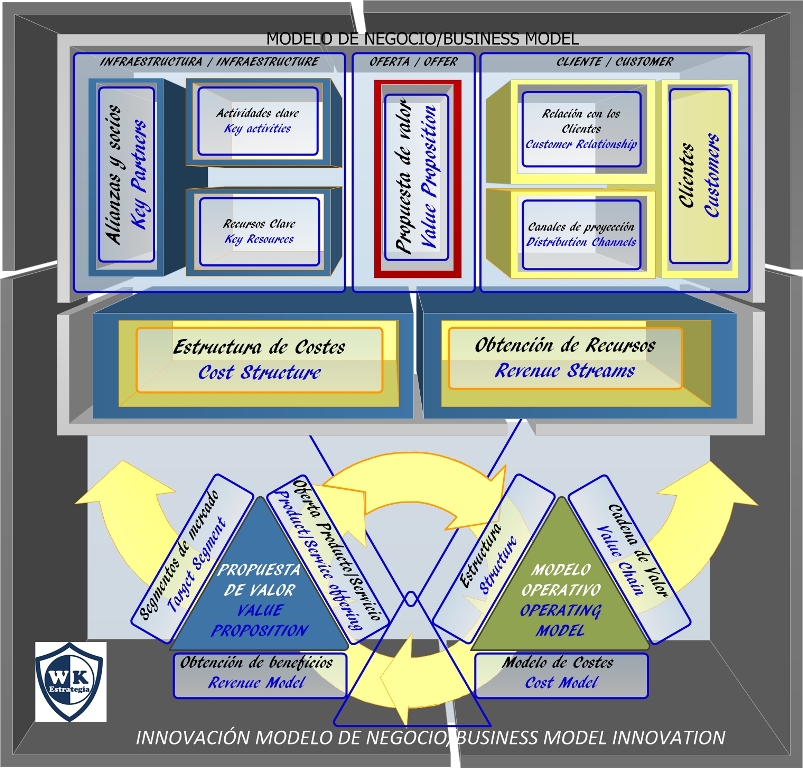
We focus on three means to generate an innovation:
- Change the way to put price and collect money in regard with these questions: how much, when and where.
- Change the way product/service meets customer needs, i.e. changing the performance of one specific service along one or more new attributes
- Change the way the Company supply the product/service. Deliver the same level of customer utility but doing it more efficiently.
CONTACT:
If you need more information about what WK Estrategia can do to help you, please send us an e-mail to info@wkestrategia.es, or click on "contact" in lower side of this web site
Transformation of inputs into outputs using physical resources.
The transformation of inputs into outputs is the concern of Operations Management. This transformation is performed by using physical resources, in order to fulfill customer utility expectations with more effectiveness and more efficiently than competitors. To have the use of physical resources is what precisely differentiates operations management from other activities of the value chain of the organization. Operations management is about matching supply with demand.
The excellence in operations has become a key ambition to stay ahead of competitors due to that small differences mark the success or failure of an organization.

Although perfection is impossible in this area, mismatches can be reduced or even eliminate through continuous learning until new ones come out with other different characteristics caused by normal adaptation to environment. Operations management never dies.
This is an issue that can be very complex, and there is not an operating environment that can be used as a model.
Tools for operations management (quantitative models and qualitative strategies) can be applied in three different but complementary ways (G. Cachon and C. Terwiesch).
- To eliminate inefficiencies, is to say, to ensure the maximum effectiveness with the existent resources
- To make effective decisions so as to achieve the correct commitment while making trade-offs between competing objectives
- To overcome technological barriers by redesigning and restructuring operations in order to improve the overall performance beyond the current and most efficient performance known.
This could be applied to profit and nonprofit organizations; private or public; with employees or volunteers and for routine or emergency operations.
Operations management aims to provide input-output conversion capabilities for reaching the organization’s goals and its strategic objectives. Certain areas require attention.
- Alignment of Ops. Management activities with the overall strategy.
- Effectiveness, or how to succeed in dealing with demand variability and uncertainty, either from the market or not, such as the wide spectrum of risks that must face an emergency room in a hospital; or the multifaceted threats for a crisis management board; or a forest fire fighting service.
- Efficiency, by improving productivity and optimal management of outsourcing non-core business processes to reduce costs.
- Value chain.
- Identify the basic capabilities of organization’s value chain, make a synchronized use of them and cross barriers between functions whilst knowledge specialization advantages in primary and support activities are preserved.
- Identify the advanced capabilities that arise from strategic alliances from each set of value chain participants employing them synchronized.
- Experience, by seizing experience in "lessons learned" in operations to improve performance and facilitate the transformation of the organization.
- Best practices. Leveraging best practices, internal or external.
- Innovation. Be able to accomplish new operational approaches to cross current technological barriers and seize economic adding value opportunities.
WK Estrategia can help you significantly to improve operations.
CONTACT:
If you need more information about what WK Estrategia can do to help you, please send us an e-mail to info@wkestrategia.es, or click on "contact" in lower side of this web site
Our Value adding propoition.
Our value adding proposal is based on the model below.
That graphic depiction has two parts. A) the logical model of a process, B) Hayes and Wheelwright product-process matrix, to differentiate types of processes due its usefulness although we know that boundaries between industries are blurring.
Today it is rapidly shifting the productive effort from intensive labor use to Services and Information based business, and probably a huge number of functions will be performed by robots. Functions whose full knowledge of how they operate, allows to establish procedures, anticipate every possible contingency and subsequent reaction to them.
Traditional ways of doing things are being replaced by more efficient new ones, where TICs become an important actor and play a major role in operations.The routine will be relegated to robots and people will become skilled on activities that require thought, creativity and design, in the broadest meaning, to improve productivity. All this will lead to a greater impact in operations. Thus the consumer is playing also a major role to design products or services and the processes to provide them. In addition, any organization is a part of society, and what it does and how it does has consequences, not only for customers but also for citizens, who cares about the impact of productive activity in society and the environment; governments who want enterprises with social responsibility; etc.
In part A) of the graphic depiction below we also represent external factors that must be taken into account in operations management.
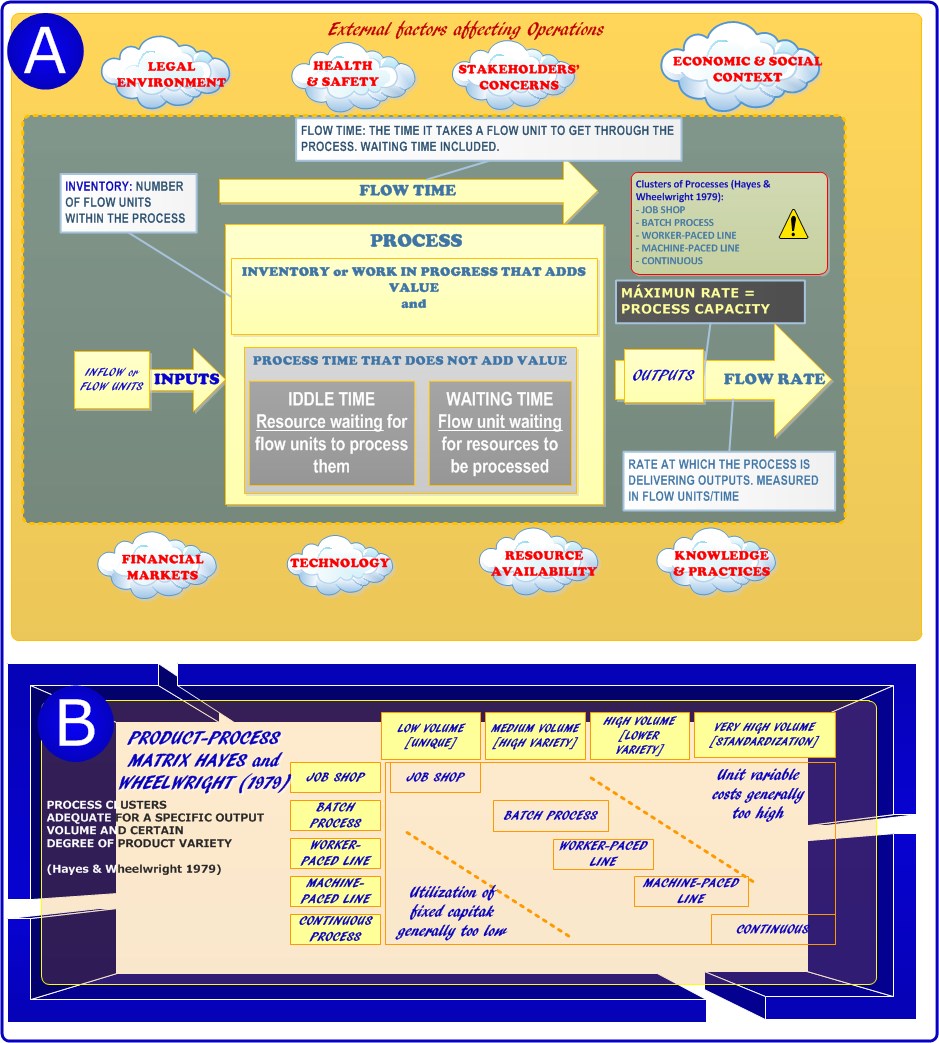
To learn more about Operations, click here.
CONTACT:
If you need more information about what WK Estrategia can do to help you, please send us an e-mail to info@wkestrategia.es, or click on "contact" in lower side of this web site
LEAN OPERATIONS. In WK strategy we can help your organization to identify the theoretic potential of your internal processes and reduce time wasted in operations that do not add value.
In the graph may be seen the seven sources of waste in operations. For example, as regards the internal transport, you may have seen that the places in your organization where different activities are being distributed or executed, are scattered and far away. Busy resources can be working hard but achieving nothing, and what it is worse, there is no value added. Correcting an error due to a poorly executed task doesn’t add value either. Bad quality is very expensive.
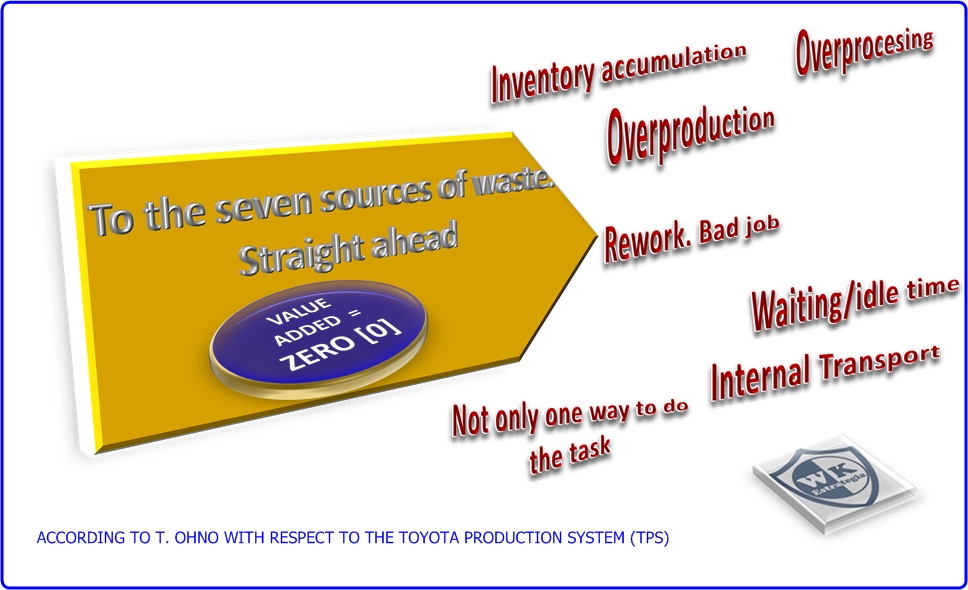
We will analyze and describe the effects of time wasting in utilization of resources and on overall quality of goods or services. The objective is to identify what activities really add value in order to have a good estimate for the potential of process improvement aimed at achieving its theoretical potential before engaging in waste reduction.
The concept of waste is applicable to manufacturing operations and service delivery. It is important to emphasize this, because in the services sector, the main production factor is labor. If we analyze carefully the day of knowledge workers, for example, could appear as likely results that only half time of resource utilization adds value, and the rest is wasted for various reasons to be identified. For example, running around (internal transport) to get supplies, or doing paperwork identical but repeated many times; looking for misplaced things or moving them from one place to another to liberate space to work, etc. This it's frustrating for the worker but also leads to poor and costly performance.
CONTACT:
If you need more information about what WK Estrategia can do to help you, please send us an e-mail to info@wkestrategia.es, or click on "contact" in lower side of this web site
Non-routine operations, could be of very different nature, such as, firefighting in forest areas; natural disasters; management of refugee camps; emergency room in a hospital; conduction of operations of any kind; etc. Nevertheless they have a primary objective, to serve the client needs and wants, and the secondary one, do it utilizing resources effectively and eficiently. Both should be balanced but bearing in mind that an improvement in one will often give a deterioration in the other Exactly the same thing that in case of routine operations.
For example, when fighting a fire in the forest, the client to be served is the task force: the people and also the material and equipment. Previously all resources must have been prepared to be fully operational and all task force teams and their relays properly trained.
After the action a review [AAR] should be conducted ir order to respond appropriately to the following four questions:
- What objectives were said to be achieved before starting the operation.
- What actually went on
- Which is the gap between those objectives and what actually went on giving all necessary details to explain the gap.
- And finally, after the analysis of the answers to the three previous questions, what should be done next time, which activities to sustain, or modify or improve.
When conducting non-routine operation of high intensity there is a critical factor: communication in order to fulfill the most informed decision to effectively achieve the primary objective. See the graphic below, and note that a greater detail as well as different perspectives must be available
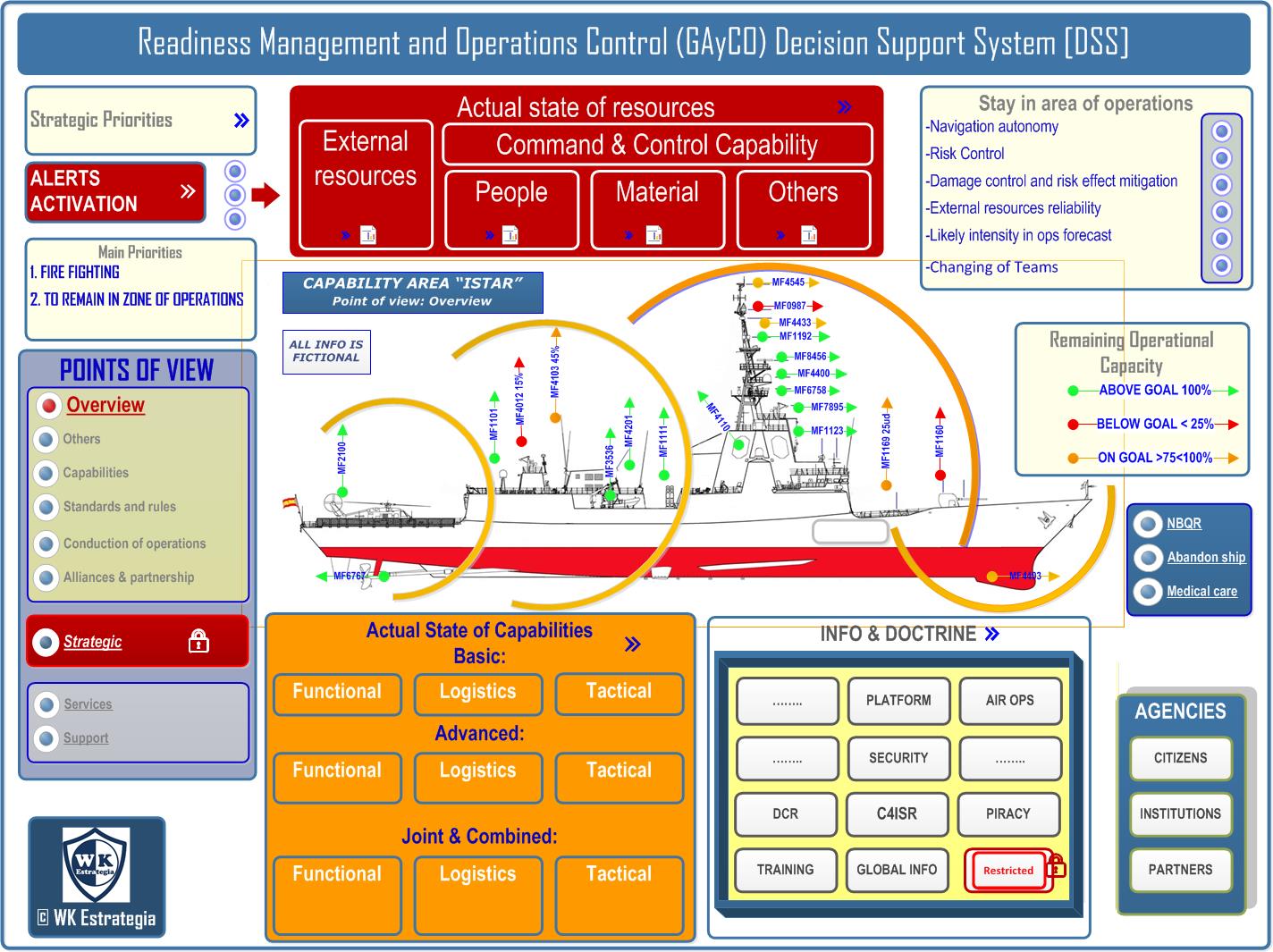
CONTACT:
If you need more information about what WK Estrategia can do to help you, please send us an e-mail to info@wkestrategia.es, or click on "contact" in lower side of this web site
Our approach to operations management is to eliminate mismatches between supply with demand. Previously strategic decisions on operations management scope and process capacity must have been made through the strategic process as the following
- Location of facilities; Plant Layouts and Material Handling.
- Product/Service Design and Process Design to make/provide them.
- Work Planning, Routing and Programming and goods/services Dispatching.
- Follow-up during operations and after dispatching
- Quality Assurance and Control.
- Materials purchasing and Management.
- Maintenance Management (to avoid or reduce breakdowns and to improve setups lags)
Process Capacity is the maximun amount that a process can produce in a given unit of time. But to determine this capacity, a greater detail in operations analysis is necessary, looking for identifying and understanding the various activities involved within a process to find out and understand the underlying process behaviour without getting lost in irritating details.
Without forgetting that the necessary objective of a business (or any organization) is to be profitable, but not maximizing utilization, WK Estrategia can help you in this complex issue by using a phased process to identify processes, that broadly encompasses the following steps:
- Analysis anchorage (choose tangible product or customer expectations to anchor analysis).
- Agreement on the boundaries of the processes, as well as key terms, definitions, expectations, etc. (probably be necessary to do an exercise of authority)
- Draw Process flow diagram (activities and inventories or buffers).
- Determine Flow Rate with a given variety of product/service and subsequent Process Capacity identifying if it is demand constrained (D>S) or supply constrained (S>D)
- Identify utilization of a process (flow rate/capacity) which is to say what actually produces relative to how much it could produce if it were running at full speed.
- Determine implied utilization of a resource (Demand/Capacity) to capture the mismatch between what could flow through the resource -Demand- and what the resource can provide -Capacity
- Identify bottlenecks.
- Identify value and non value adding activities. Reject non value adding activities.
Once processes are properly identified and their most relevant variables determined, the organization is better known to itself and then the "forest can be seen from above, from the bottom and from both sides" using what we call graphic depiction fit for purpose, that are designed by customers but maintaining consistency with overall strategy. The aim is to maintain on a daily basis a close tracking of operations within the goals and objectives of strategy besides getting effective communication across the organization.
For example, in the graphic below you can see a partial graphic depiction about certain objectives in teaching and research, in this case certifications to be obtained by the organization in these fields.
You can use a graphic depiction designed by the customer and fit for purpose, but still consistent with the overall strategy properly updated. The objective is twofold:
- For one keep adequate track of daily operations within the framework of the strategic goals and objectives,
- On the other, achieve effective communication with all stakeholders about what the organization together, alone or jointly with strategic partners, pursues.
In WK Estrategia we think that capabilities are developed through the best running of specific processes, and although actions to be taken will be sponsored by respective teaching and research committees, they must also be agreed with different parts of organization, that should participate in order to maintain the necessary unity of effort in resources utilization. To follow up this, key performance indicators lined up with strategic formulation at a given time are properly updated on this graphic depiction. (only available in the spanish version -all data are fictitious-).
One important consequence of this methodology, and not only in services based business, is to create, on a regular basis, a core focus, that helps to get honest coordination and proactive collaboration by setting a common language and show a common goal to all disciplines involved.
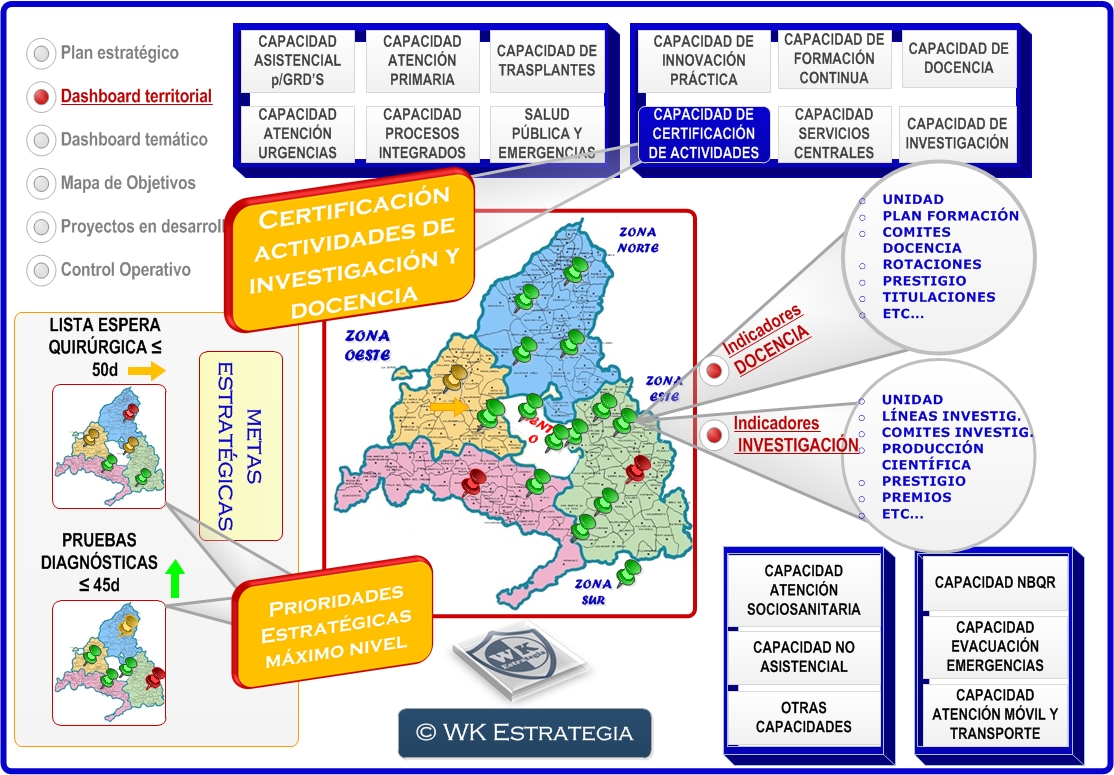
CONTACT:
If you need more information about what WK Estrategia can do to help you, please send us an e-mail to info@wkestrategia.es, or click on "contact" in lower side of this web site
Project Management. An overview.
A Project is a temporary endeavor undertaken to create a unique product, service or result and most of the times pursues a lasting outcome. Every project has some specific objectives to be achieved with regard to its scope, cost and time, being quality affected by balancing these three objectives. To do this, project manager uses and integrates knowledge, deploys needed skills, uses certain tools and applies specific techniques.
There are many types of projects, but basically its a puzzle of intertwined activities some of which, but not all, are dependent and have influence on one another, and at the very first moment of its beginning aims to an specific end. A project is always affected by some degree of uncertainty, thus the greater the uncertainty, the greater the threat of not achieving the desired end, and terminating as a failed project.
A Project is based on a strategic business necessity, whether organizational, technological, market, legal, etc. so a project becomes a set of activities aimed to an important objective in regard with corporate, competitive or functional strategy.
Project management can be placed in two management disciplines "management control" or "operations management". Shipyards probably deploy much of their time and resources in the execution of different projects as if they were operations -complex and not standardized-. The same can be said for construction companies that build roads, canals and ports.
We believe that depending on the specific circumstances of the organization, both approaches are valid and enforceable. see each.
Management Control point of view: Management Control is performed to get the implementation of the strategic formulation as its most important goal. So, from this point of view, project management focus is twofold:
- Projects that have significant influence on Strategic goals
- Projects whose organization, control, and resource consumption does have sufficient magnitude to be necessary to integrate it in the system of management control.
Operations Management point of view: We can also say that is a nonroutine work or nonrepetitive operation and could be placed within the field of operations management, [Cachon & Terwiesch] with different activities to be completed as part of the project, which all of them have a limited time frame, a limited budget and a specified quality. From this point of view, there are different activities to be mapped; an underlying behaviour of the process to be discovered and understood; different degrees of uncertainty to deal with, such as facing unknown activity times; iteration or rework loops, or even the worst, that is the potential threat of terminating the project instead of being completed, specially when we don't even know the unknowns around the project and too many iterations must be done before getting the deliverables.
CONTACT:
If you need more information about what WK Estrategia can do to help you, please send us an e-mail to info@wkestrategia.es, or click on "contact" in lower side of this web site
You set your level of ambition in the project result.
Our proposal is to advise or manage your project to succeed. The project implementation is done through all the activities taking place in each and every process groups, but the execution is not automatic, though is highly recommended to have experience in the following 5 areas indicated in the graphic below: 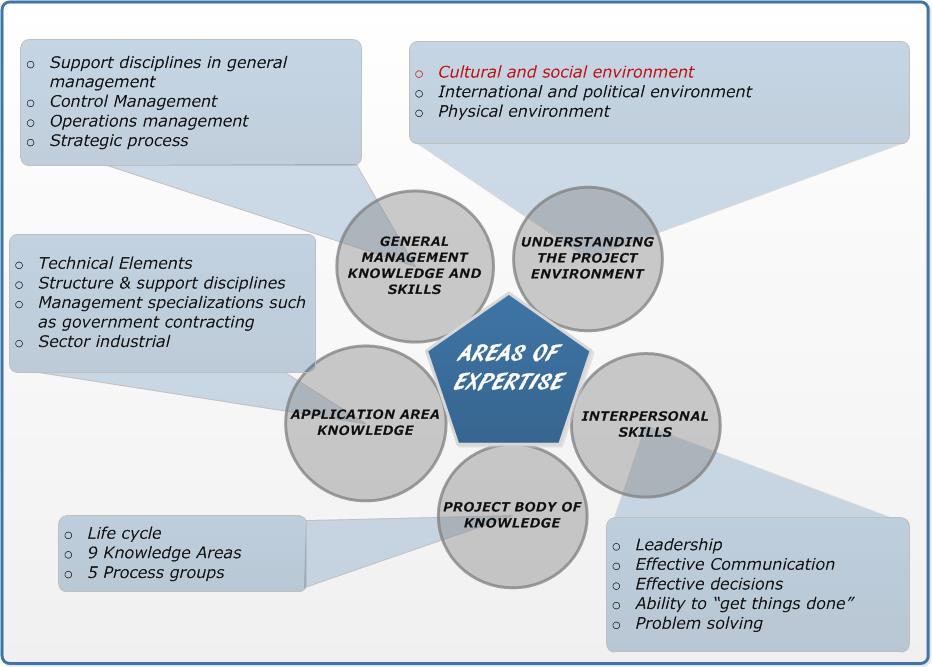 Specific knowledge are also required in 9 different areas of knowledge. Therefore project management has three key elements, "areas of expertise" as general knowledge necessary; "processes" running all necessary steps to successfully complete the project activities, and areas of specific knowledge which are considered as the best practices in this discipline.
Specific knowledge are also required in 9 different areas of knowledge. Therefore project management has three key elements, "areas of expertise" as general knowledge necessary; "processes" running all necessary steps to successfully complete the project activities, and areas of specific knowledge which are considered as the best practices in this discipline.
In the chart below, correlation between process groups and knowledge areas is shown: 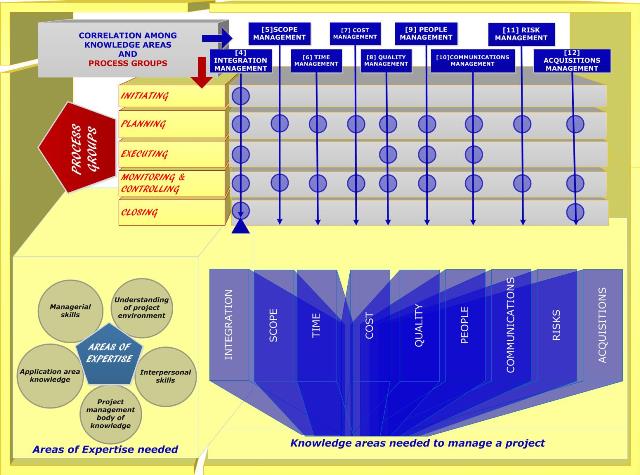
To understand the correlation between processes to perform and knowledge to have, is really important because it allows to know the specific range of knowledge needed to properly perform, control and steer the various activities of each process in order to get the best project management team.
There's more than one way to manage a project. Details have influence on project results, and therefore the level of the project results. The following details should always be considered to impact the project results:
- Complexity,
- Risk,
- Size,
- Time frame,
- Project team’s experience,
- Access to resources,
- Amount of historical information
- Organization’s project management maturity,
- Industry and
- Application area
The required process groups are guides to apply appropriate project management knowledge and skills while developing the project. The underlying concept for the interaction among the project management processes is the Plan-do-check-act cycle (Deming and Shewhart 1999)
After determining the level of ambition in your project results we will advise you in this:
- Which processes will be used in order to avoid all the unnecessary burocracy
- Who will use them regarding to the knowledge and expertise needed
- Level of Rigour needed to achieve the project objective.
CONTACT:
If you need more information about what WK Estrategia can do to help you, please send us an e-mail to info@wkestrategia.es, or click on "contact" in lower side of this web site
Public Procurement. Our years of experience give us knowledge enough and readiness to help you in this matter.
This concept may seem daunting at first due to the lack of skills and knowledge in tendering process.
See the document at the end, it could be of your interest (spanish version)
In December 2011 the Commission proposed the revision of Directives 2004/17/EC (procurement in the water/energy/transport/postal services sectors) "Sector" and 2004/18/EC (public works, supply and service contracts) "Classical", as well as the adoption of a directive on concession contracts.
The new directives were adopted by the Council on 11 February 2014. The currently applicable “Sector” and “Classical” public procurement directives remain in force until 17 April 2016.The Member States have until that date to transpose the new rules into their national law (except with regard to e-procurement, where the deadline is September 2018).
When becoming involved in a tendering process, it is important to bear in mind your suitability for the project. Not only if the current situation of your business says that it is perfectly fitted for tendering, but also your ability to manage the contract if your business is finally awarded with a specific contract. By understanding these points in order to ensure that you can demonstrate your ability to meet the criteria and offer a competitive bid, you will increase your chances of success.
Tendering is the process of making an offer, bid or proposal, or expressing interest in response to an invitation/request for tender made by another organization, whether public or private, in order to get supplies, services or infrastructure through the contract awarded that best meets with its criteria and provides the best value for money.
The tendering process may differ between Government and private sector, but both groups generally look for similar things, such as the best value for money in regard with quality, reliability, efficiency, sustainability and added value. These are common elements sought after when evaluating tender submissions.
In public procurement, the main steps in the tender process are the following:
- Selection of tender procedure: Open, Restricted, Competitive Negotiation, Electronic Auction, Competitive Dialog and Innovation Partnership.
- Outline of requirements, establish criteria of award and how tenders should respond along with the corresponding documents of technical competence and specifications that meet the requirements and administrative clauses that will rule the terms of the contract after being awarded.
- Tenderers are invited (personally or through contract notices). The estimated value of procurement, complexity and business category determine how tenders are invited in order to assure that the contract objectives will be achieved both technically and economically by the eventual winning tender.
- Those participants interested in bidding respond in order to obtain all relevant documentation. And when appropriate they should:
- Attend any briefing sessions being conducted in regard with the invitation
- Clarify any uncertainties
- Plan and prepare their proposal
- Submit their proposal in the right format, on time and at the right location.
- Evaluation and selection: each tender will be checked for compliance, and if compliant, then evaluated against the criteria specified in the tender documentation. The tender that offers best value for money in accordance with the procedure laid down in contract documentation should be the winner and then be awarded.
- Notification and debriefing: when a contract has been awarded, the successful tenderer will be advised in writing of the outcome. Unsuccessful tenderers are also advised and offered a debriefing interview.
- Contracts established and managed: a formal agreement will be required between the successful tenderer and the relevant agency.
Tenders usually can be issued through the following forms:
- Expressions of interest (EOI) - used to develop a shortlist of potential tenderers
- Request for information (RFI) - ir order to collect information to outline the project but not to chose the tenderer.
- Request for proposal (RFP) - if the proposal of variants is allowed in documentation when there is the posibility of an innovative or more efficient solution.
- Request for quotation (RFQ) - Tenderers are invited to provide a quote for the provision of works, goods or services.
- Request for tender (RFT) - an invitation to tender by public advertisement open to all suppliers.
If you are a SME, please see this link (spanish version)
CONTACT:
If you need more information about what WK Estrategia can do to help you, please send us an e-mail to [email protected] , or click on "contact" in lower side of this web site
Public Private Partnership -PPP- building. We can help you in this evolutionary and challenging issue
The estimated value of tenders published in TED (including utilities) amounts to 420 billion euros in 2009, 467 in 2010, 425 in 2011, 401 in 2012.
The European Parliament, in its Resolution on PPPs of 2006, acknowledged that practitioners want clarity about the application of procurement law to the creation of public-private undertakings in connection with the award of a contract or concession.
During the last decade, the PPP phenomenon developed in many fields falling within the scope of the public sector due to:
- Budget constraints confronting Member States,
- The desire to benefit more in public life from the know-how and working methods of the private sector.
- PPP is also part of the more general change in the role of the State in the economy, moving from being direct operator to one of organiser, regulator and controller.
Equal treatment and transparency.
IPPP must remain within the scope of their initial object and can as a matter of principle not obtain any further public contracts or concessions without a procedure respecting Community law on public contracts and concessions.
However, as the IPPP is usually set up to provide a service over a fairly long period, it must be able to adjust to certain changes in the economic, legal or technical environment as long as the principles of equal treatment and transparency. But changes to essential terms of contracts not provided for in the initial tender documents require a new procurement procedure
One possible way of setting up an Institutionalised PPP, which is, in the Commission’s view, suitable for complying with the principles of Community law while at the same time avoiding a double1 tendering procedure, is as follows:
- The private partner of the IPPP is selected by means of a procedure, the subject of which is both the public contract or the concession which is to be awarded to the future public-private entity, and the private partner's operational contribution to perform these task and/or his contribution to the management of the public-private entity.
- The selection of the private partner is accompanied by the founding of the IPPP and the award of the contract or concession to the public-private entity.
Characteristics.
As is set in the "Green Paper" of public procurement, the following elements normally characterise PPPs:
- The relatively long duration of the relationship, involving cooperation between the public partner and the private partner on different aspects of a planned project.
- The method of funding the project, in part from the private sector, sometimes by means of complex arrangements between the various players. Nonetheless, public funds - in some cases rather substantial - may be added to the private funds.
- The important role of the economic operator, who participates at different stages in the project (design, completion, implementation, funding).
- The public partner concentrates primarily on defining the objectives to be attained in terms of public interest, quality of services provided and pricing policy, and it takes responsibility for monitoring compliance with these objectives.
- The distribution of risks between the public partner and the private partner, to whom the risks generally borne by the public sector are transferred. However, a PPP does not necessarily mean that the private partner assumes all the risks, or even the major share of the risks linked to the project. The precise distribution of risk is determined case by case, according to the respective ability of the parties concerned to assess, control and cope with this risk.
Destination.
In the current economic climate, cooperative ventures between public authorities and private enterprise can provide effective ways to:
- deliver infrastructure projects
- provide services to the public
- finance innovation (thereby contributing to economic growth and job creation)
As part of the Initiative for Growth, the Council has approved a series of measures designed to increase investment, mainly through forms of PPPs, in:
- the infrastructure of the trans-European transport network
- the fields of innovation, research and development
- partnership structures (public, private, or a combination thereof) with the private sector to administer public services, particularly at local level, such as those concerned with waste management or water or energy distribution
1 one for selecting the private partner to the IPPP and another one for awarding public contracts or concessions to the public-private entity.
CONTACT:
If you need more information about what WK Estrategia can do to help you, please send us an e-mail to info@wkestrategia.es, or click on "contact" in lower side of this web site
To internationalize your company you need a plan and then work on that plan... Unless you hate planning and therefore love the risks wherever they come.
Please go to this link. Only spanish version available at this moment
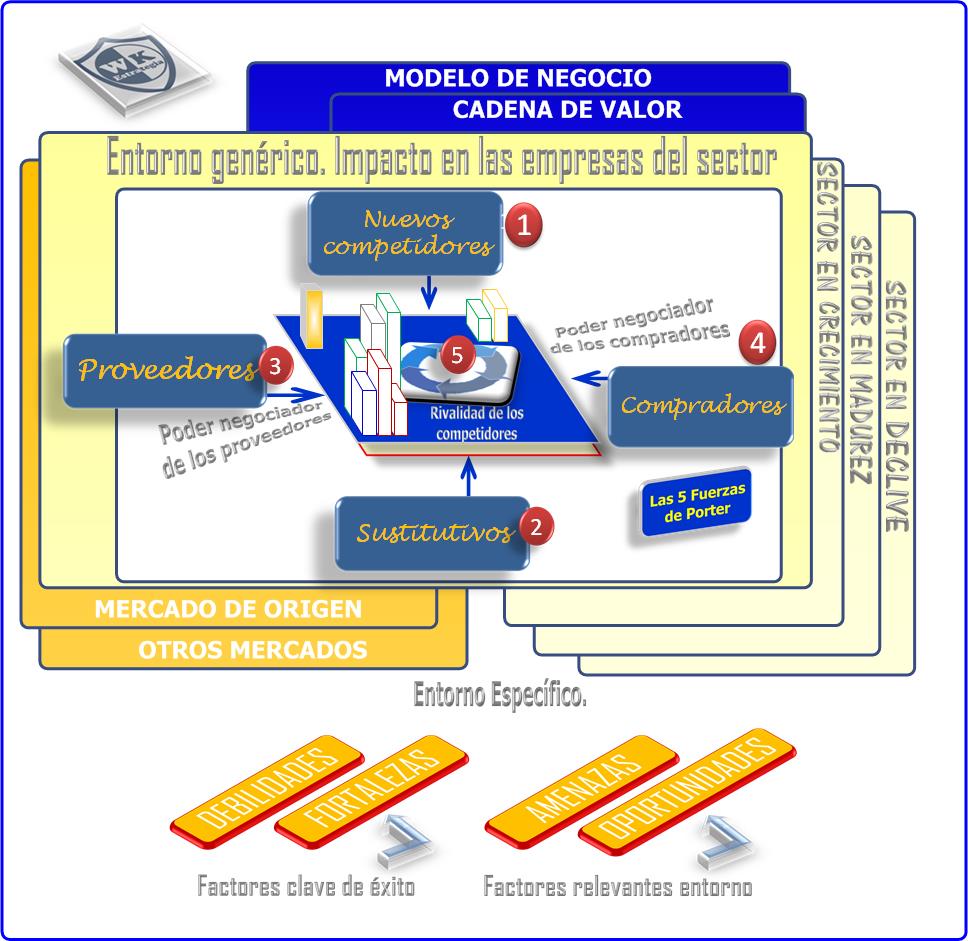
Contact
If you need more information about what WK Estrategia can do to help you, please send us an e-mail to info@wkestrategia.es, or click on "contact" in lower side of this web site
The European Union expresses its political priorities through the Multiannual Financial Framework (MFF multiannual Financial Framework) a tool for planning that lays down the maximum annual amounts ('ceilings') which the EU may spend in different political fields ('headings') over a period of at least 5 years. The upcoming MFF covers seven years: from 2014 to 2020.
The annual budget is adopted within the MFF and usually remains below its expenditure ceilings in order to retain some flexibility to cope with unforeseen needs. The annual budget in turn must be the result of joint measures necessary to implement the Europe 2020 strategy and achieve its objectives effectively and efficiently.
It is important to have a good advisor if you do not want to be lost in a sea of definitions, procedures, application programmes, policies, guidelines… example of this complexity is the corresponding public procurement theme that requires separate attention. You need a clear view to know how to go ahead without making mistakes in the "approach channel", ie definition, procedure, programme, standard or authority.
We put another example of all this: The European Commission proposed, and achieved, that for the time horizon of the European strategy, from 2014 to 2020, each member state replace the previous "National Strategic Reference Framework" (2007 to 2013) by the "Association Agreement" imposed by current standards. If your organization knew the previous methodology used to lay down the strategy, now will have to understand the new structure, its new terms and definitions and so on. Only the number of pages remains similar, over 200 pages each ...
As an example of what WK Strategy can do for you to keep a comprehensive approach, see our overview of the State and Trends of the EU general policies in the Thematic layer.
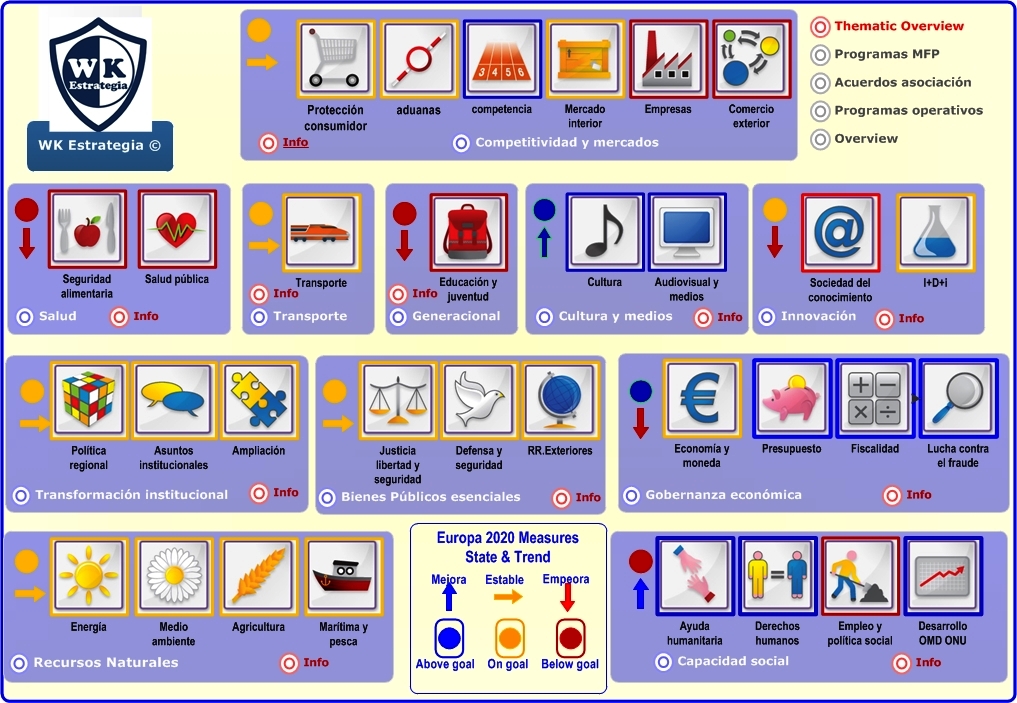
CONTACT:
If you need more information about what WK Estrategia can do to help you, please send us an e-mail to info@wkestrategia.es, or click on "contact" in lower side of this web site
Take advantages of Europe 2020 strategy.
All Member states have committed to achieving Europe 2020 targets and have translated them into national targets and growth-enhancing policies. Each year the European Commission undertakes a detailed analysis of EU Member States' programmes of economic and structural reforms and provides them with especific recommendations for the next 12-18 months. Therefore the European Commission has set up a yearly cycle of economic policy coordination called the European semester which starts when the Commission adopts its Annual Growth Survey, usually towards the end of the year, which sets out EU priorities for the coming year to boost growth and job creation.
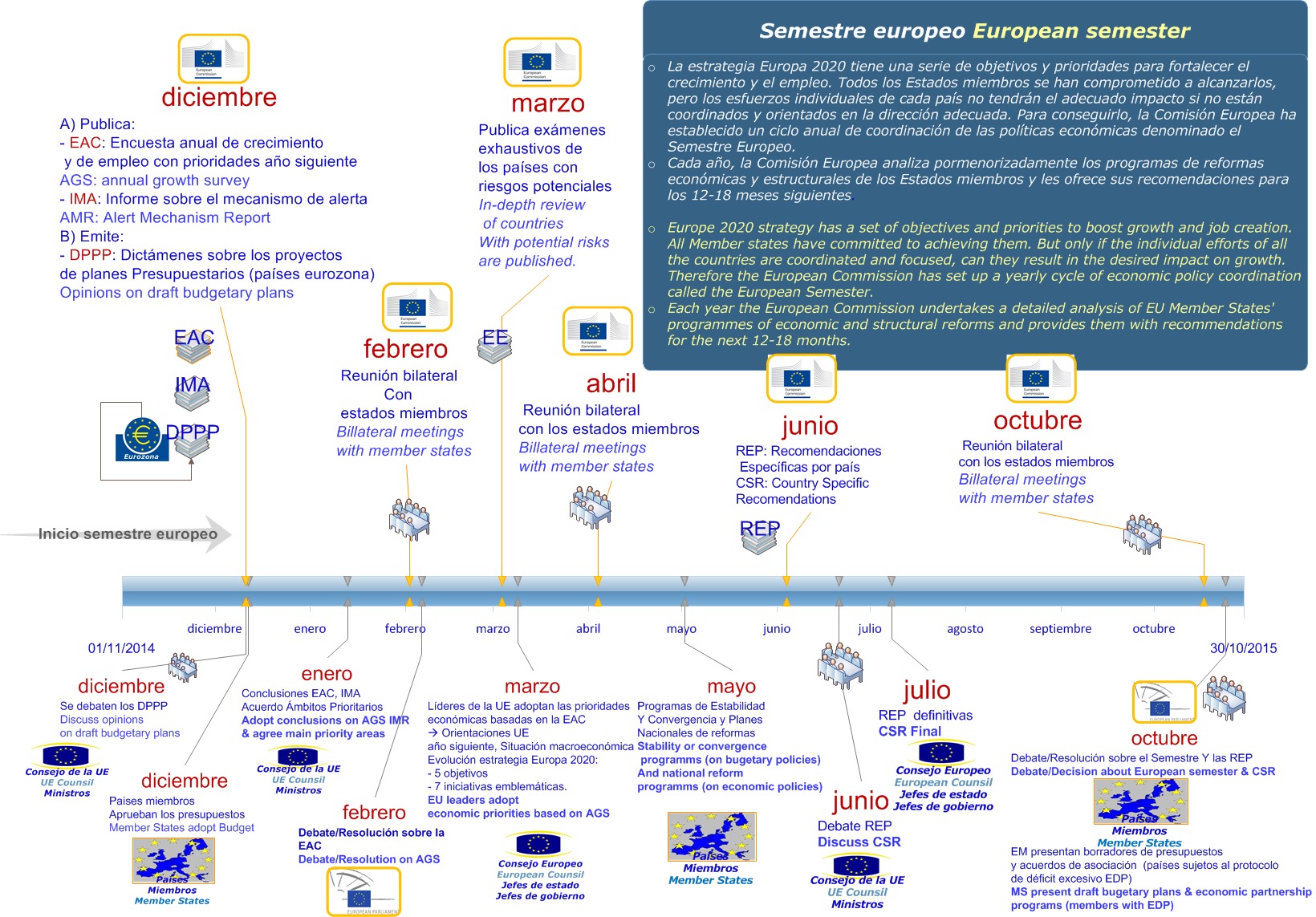
CONTACT:
If you need more information about what WK Estrategia can do to help you, please send us an e-mail to info@wkestrategia.es, or click on "contact" in lower side of this web site
The policies of the European Union are held by a broad spectrum of programmes and funds to ensure financial support for the potential beneficiaries, ranging from small entrepreneurs, students, scientists, etc. to cities, or regional and national governments.
The "Approved" for the five categories of spending Multiannual Financial Framework 2014-2020 programs are 44. We cite the following 15:
- Competitiveness of Enterprises and SMEs (COSME)
- Customs, Taxation and Fight against Fraud
- Creative Europe
- Employment and Social Innovation Programme
- EU Civil Protection and European Emergency Response Coordination Centre
- European Maritime Affairs and Fisheries
- Erasmus +
- Europe for Citizens
- Galileo
- Health
- Horizon 2020
- Instrument Contributing to stability and peace
- Internal Security Fund
- IT systems
- Youth employment initiative
The quantity of rules (only EU’s Directives and Regulations) affecting directly to these programmes are so far 59.
The number of "sites" that link for more information about each program, are 28 so far, which in turn are different from the EU permanent sites. As in the program Euronews "No Comment".
In WK strategy we can help you to be focused on your strategic goals while you are seizing emerging opportunities from Europe 2020 strategy and its corresponding Multiannual Financial Framework -and its programmes- without getting lost in a forest that is still densely populated by bureaucracy.
CONTACT:
If you need more information about what WK Estrategia can do to help you, please send us an e-mail to info@wkestrategia.es, or click on "contact" in lower side of this web site
Only spanish versión available; go there to see more.
CONTACT:
If you need more information about what WK Estrategia can do to help you, please send us an e-mail to info@wkestrategia.es, or click on "contact" in lower side of this web site
The Horizon 2020 programme is one of the 44 approved so far. It belongs to the category of "Competitiveness for growth and employment" and is one of the most favored in the MFP (Multi-annual financial framework 2014-2020). It is intended primarily to private beneficiaries, with an amount for that period of € 79.401,83 million (at current prices).
{The Horizon 2020 programme aims at securing Europe's global competitiveness, strengthening its position in science and its industrial leadership in innovation by providing major investment in key technologies, greater access to capital and support for SMEs. The programme aims at tackling societal challenges by helping to bridge the gap between research and the market. Horizon 2020 is designed to be a different kind of EU research programme - funding the entire value creation chain from fundamental research through to market innovation}
The UE will invest in key technologies and by means of a more easy access to finance will benefit SMEs.This is crucial for overcoming existing barriers at the national and EU level.
Legal basis:
- Regulation (EU) No 1291/2013 establishing Horizon 2020 - the Framework Programme for Research and Innovation (2014-2020).
- Regulation (EU) No 1290/2013 laying down the rules for participation and dissemination in Horizon 2020Decision establishing the specific programme implementing Horizon 2020
- Regulation (EU) No 1292/2013 establishing the European Institute of Innovation and Technology
- Decision No 1312/2013/EU on the strategic innovation agenda of the European Institute of Innovation and Technology (EIT): the contribution of the EIT to a more innovative Europe
- Regulation (EU) No 1292/2013 establishing the European Institute of Innovation and Technology
- Decision No 1312/2013/EU on the strategic innovation agenda of the European Institute of Innovation and Technology (EIT): the contribution of the EIT to a more innovative Europe
CONTACT:
If you need more information about what WK Estrategia can do to help you, please send us an e-mail to info@wkestrategia.es, or click on "contact" in lower side of this web site
What’s competitive intelligence?... it is information, not spying.
Competitive intelligence (CI) has different meaning for every component within the organization. It doesn’t mean the same to sales people; to the managing director; to the executive board, etc. but its ultimate purpose is to help to decision-makers and action-takers make better-informed, timely and accurate decisions and enhance organization’s performance, due to that CI is a part of Knowledge management, because this process that retrieves information to turn it into intelligence can provide the organization with new ideas.
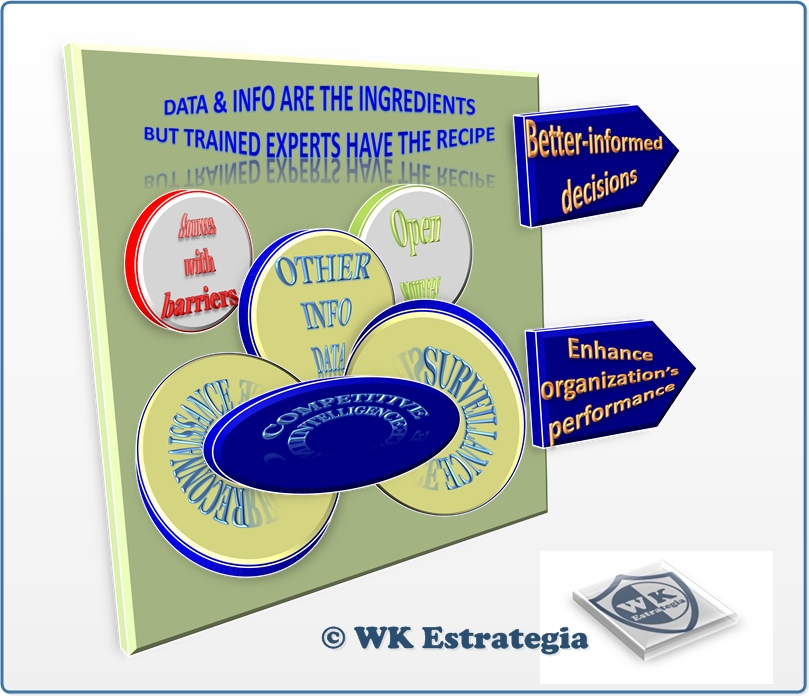
CI uses information obtained from numerous sources such as following:
- news media and web (but the most valuable information rarely comes from easily accesible on-line sites)
- customer an competitors interviews,
- experts in different fields,
- international or local trade fairs,
- open access data bases,
- government and sectorial information,
- technology surveillance
- others …
As stated in the NATO, Intelligence is the final product derived from the analysis and processing information and data obtained from two good servants: surveillance and reconnaissance, fused with other information.
Surveillance is the persistent monitoring of a target, so is a more prolonged and deliberate activity. Reconnaissance is the information gathering conducted to answer a specific issue, so are rapid and targeted to retrieve specific information.
Intelligence as a final product, should be disseminated based upon two concepts “need to know” and “need to share” with a mind-set of information assurance (data and networks) in order to facilitate the big picture of specific or interesting issues that could affect the enterprise. Why the need to share?, because you find that information is only of value if you give it to people who have the ability to do something with it. The fact that I know something has zero value if I'm not the person who can actually make something better because of it1.
Competitive intelligence is crucial for all organization’s operations, and doesn´t have to be related to secret but if it were, intelligence must be protected, so although you don’t make industrial espionage you’d better be prepared for doing counter espionage.
In this issue, two things are needed:
- Trained experts in Competitive intelligence (own experts or outsourcing of CI) that understand how to use CI to support decision-makers at all and at their respective level along with information assurance (info, data and networks)
- Time and special procedures to obtain secure, holistic and relevant information, using resources effectively and efficiently. There must be a plan for developing CI and creating short term wins, instead of hoping for them.
1 Four star general Stnaley McChrystal
CONTACT:
If you need more information about what WK Estrategia can do to help you, please send us an e-mail to info@wkestrategia.es, or click on "contact" in lower side of this web site
When starting up your business you must firstly focus on these key areas:
- Financial and cash flow forecast for next 4 or 5 years; profitability; Key Accounting information; Taxes and budgeting; risk management and insurance.
- Employee Management. You’ll need to know how you should manage HR with effectiveness, how to recruit them, to know all the relevant employee entitlements, etc.
- Marketing.
And besides this you need to develop a Business plan. Let's focus on Marketing and your business plan
Marketing.
With regard to marketing you need to meet value adding expectations from your potential customers against making profits for the organisation. You must have a Customer orientation that involves focusing your business on identifying and understanding your customers' needs and preferences in order to make that your "Unique Selling Proposition" USP, stands out from competitors, such as best service, best value, cheapest, most modern, only for élite people. etc.
No single strategy fits for all businesses, so you'll have to Choose your Competitive Strategy. There are three types of competitive strategies (M. Porter)
- Cost leadership - aimed to provide goods and services at a lower cost than competitors.
- Differentiation - aimed at creating a highly differentiated product.
- Niche - aimed at effectively serving few -or smaller- market segments rather than dealing with the whole market.
Set your Marketing objectives. After defining your unique selling proposition, you will be able to identify why customers purchase what you offer them. Then define what is to be accomplished through your marketing activities. Your objectives must be "SMART", is to say: specific, measurable, agreed upon, realistic and time bound.
Understanding of Market types. The success of your marketing strategy also involves gaining a comprehensive understanding of the markets that you serve. See each:
- Retail markets: aimed to consumers for their own.
- Business to business markets: aimed to various businesses, governments and market intermediaries to facilitate the finished product which is generally then re-sold to an end user.
Market research. You need to plan, collect and analyze specific information to segment markets, to decide on target areas, to identify the best way to position your business regarding to your competitors, to understand market trends, and also can assist in forecasting sales and anticipating events and market changes that can impact your business. So you should identify: a) your customers; b)your competitors: direct and indirect; c) the various Environmental factors that could affect your business performing the PEST analysis (Political, Economical Social & Cultural, and Technological); and d) your business' internal strengths and weaknesses and the external opportunities and threats performing a SWOT analysis in order to build on your strengths to reduce your weaknesses, seize opportunities and neutralize the potential threats.
Marketing planning. Starts with deciding on a business description and involves segmenting your market, targeting the most profitable segments, and positioning your products and services effectively in the marketplace. It also involves choosing the right marketing mix (the four p's, product, place, price and promotion) for your business to maximise the effectiveness of your marketing efforts.
Business Description allows you to get your idea, plan and vision, written black on white, when you start. It provides a thorough explanation of what your business is and the most appropriate direction to go. Businesses should also understand the performance of competing products and the target customer expectations with regard to competitors.
Market Segmentation groups your customers into segments that will require a different marketing mix strategy. You can segment your market based on different variables such as life style, demographics, age, behaviour, geography, etc.
Targeting. Once you have segmented your market you should choose target market segments in order to develop different marketing strategies for different customer groups, specially at present day, when almost every particular client needs a different marketing strategy.
Positioning is the process that produces the product's (o services') image and places it in the customer's mind; is the main process to get the customers become aware of brands and their prestige. Positioning effectiveness determines whether a client thinks of the product/service, and it could go from a luxury item to an useless offering. Business should establish a clear perception of their business in customer's minds and then bridge the gap by influencing this perception through strategic promotional activities and by chosing the optimal marketing mix.
Business Planning:
This is a key process when starting up. Many businesses enter the market arena without clearly defined objectives and strategies. When starting up a business, you’ll get a higher chance to succeed if you develop carefully and thoroughly your business plan.
You need a Sales plan.
- State the Mission, the reason for being and the Vision to stimulate progress
- Assess thoroughly your situation using a SWOT analysis (Strenghts, Weaknesses, Opportunities and Threats)
- Then establish your goals to seize opportunities and neutralize threats to your business aligned with Vision and Mission.
- Establish strategies with SMART objectives to reach your goals and develop KPI's (Key Performance Indicator) to check
- Assign responsibility for specific tasks to workers and managers.
- Design thoroughly your plan to organize information and data and empower everybody to follow the plan.
- Make a planning for and creating short terms achievements aligned with overall strategy goals to keep the sense of urgency.
You need an Operating Plan in which you will design your business concept of operation and determine its physical resources necessities through an Operating plan. At least there are four issues to be determined:
- People: number of employees, skills and training necessities; recruiting strategies to hire the best people and to get proper commitment from them; guidelines, rules and procedures for ending labour force contracts; etc
- Systems and processes: arrangement of management and staff and their roles and functions; facilities and equipment, etc.
- Equipment & facilities and to have the right equipment in place at the outset. This includes not only production equipment but administration and communication equipment. After determining the equipment you require, you will also need to finance the costs.
- Risk management from natural disasters to bad debts or slowness in paying, going by family issues. You can use four strategies: Prevention, Avoidance, Transfer or Mitigate.
You need a Management plan. Because no person knows how to do well everything. Probably you will need to delegate some roles in key business areas. You should be sure of having a suitable management structure, how to get proper commitment and how to reward people when goals were achieved. Job descriptions provide clearly communications about individual's roles and their responsibilities. It also can be used to develop performance measurement by setting Key Performance Indicators (KPI's), acreer opportunities, learning and training, etc.
You need a Financial plan. Assets to be owned or rented; financial obligations (liabilities); Equity: the amount left over after you have deducted total liabilities from total assets (capital contributions and retained earnings). Financial Requirements: all the potential costs you will face in starting up a new business. Securing finance: by identifying available sources of finance, understanding government grants and assistance, assessing the available financing options, etc. Profit and loss statement: that communicates the profitability of your business in a particular financial period. Balance sheet: The balance sheet or Statement for Financial Position, provides you with the ‘net worth' of your business' assets and liabilities at a certain date. Cash flow statement in a given period, is to say, inflows that represent the cash the business receives and cash outflows are all the cash the business expends during that given period. Budget, as a planning tool to benchmark performance making a comparison between expected and actual income and expenditure.
And finally you need an Action plan, to organize and prioritize certain actions, those you'll have to perform to properly achieve your business Mission objectives and Vision goals. Firstly, you ought to take the overall strategy you've chosen or your business and breaking it down into a cascade of smaller and achievable operating objectives, once you did it, and not before, you must identify and define specific actions in specific areas that you'll need to perform to reach those objectives.
The following issues, for each action, must be clearly settled:
- Timeframe and priorities within each action and aligned with overall strategy, .
- The people who are, or will be, responsible for undertaking each action.
- Set the appropriate key performance indicators, to steer properly and control your Action Plan. Use these three categories:
- Lagging -what happened-,
- Current -what's happening- and
- Leading -what should be done from now on-
CONTACT:
If you need more information about what WK Estrategia can do to help you, please send us an e-mail to info@wkestrategia.es, or click on "contact" in lower side of this web site
Running business.
First of all: there are 8 key areas in every business organization and they should have their corresponding strategic (and SMART) objectives to be achieved:
- Marketing
- Innovation
- Productivity
- Structure (human organization in a synchronized fashion with a common purpose)
- Financial
- Physical resources
- Social responsability
- Profits.
Second, you need to have in mind your value chain and how do you create value through performing primary and secondary activities using your core competencies.
Third, you should never forget that the environment evolves, thus you need to have a continuous awareness of the situation and assess potential consequences of expected events and probabilities and impact of unexpected events, be direct or indirect.
And fourth, after starting up, you must run your business the best you can, so you’ll be concerned with its continuity, your leadership, and a plan B, is to say, what you’ll do to manage your business through an economic downturn implying reduced workloads and redundant jobs but hiring opportunities; reduced cash flows and more difficult access to finance, but also to have the opportunity to get your business leaner and stronger; etc.
See in the following graph the general description of the approach that we have in WK Estrategia about running your SME
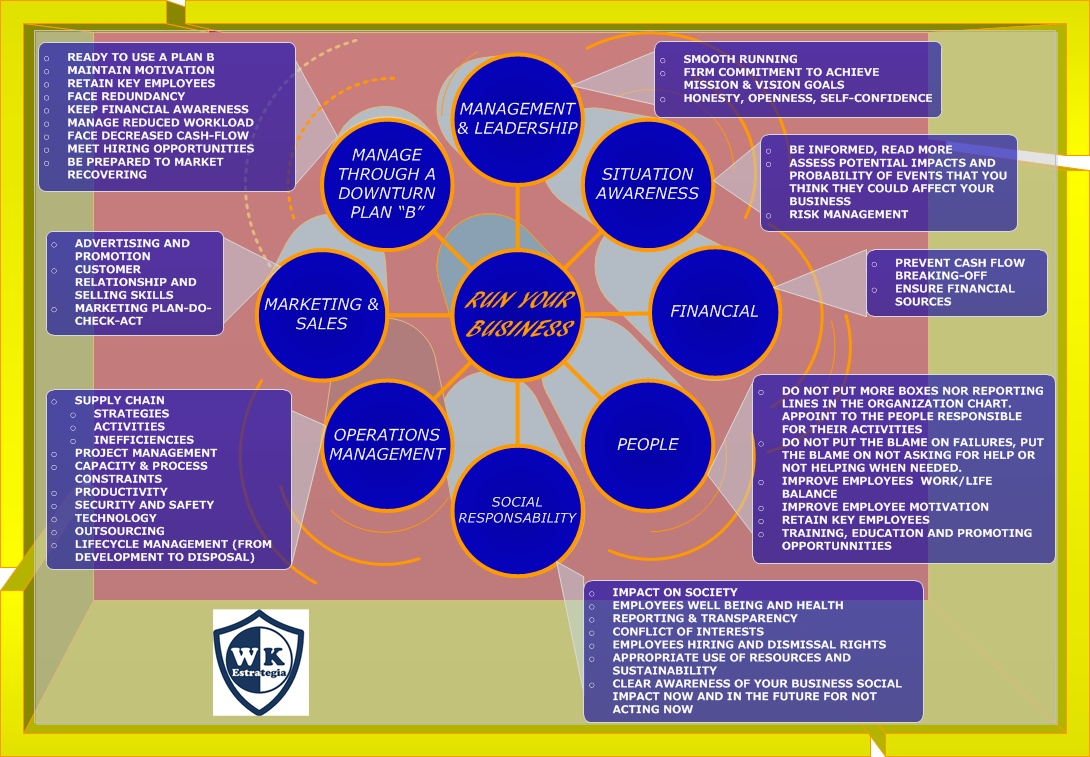
Continuity Management.
- Strategic process management is involved with developing and executing strategies in order to get effective formulation and implementation of strategic plans. This requires careful strategic planning and controlling of strategy-related decisions and actions to achieve the mission and vision goals. Also a firm commitment towards achieving desired objectives is necessary with the ability to communicate effectively, inspiring employees to meet challenging opportunities.
- Preserving the business. There are some important issues that can not be neglected:
- Honesty and openness leadership
- Maintain tangible and intangible assets.
- Build a learning organization
- operations management to address capacity challenges
- Maintain fidelity from your customers
- Cash-flow and financial
- profitability
- Risk management. Situation awareness is an essential for maintaining the continuity of a business, not only for the present but also for the future. Basically four strategies can be implemented in regard with Risk management: a) Prevention, b) Avoidance, c) Transfer and d) Mitigation.
- Risks can have different sources:
- Tougher competition
- Bad debts from customers
- Decreased cash flow
- Breakdown of equipment and facilities
- Key employees turnover
- Theft
- Natural disasters
Plan B. Managing through a Downturn:
An economic downturn is not a period of good news neither for owners nor employees and what is worst, you have neither control over its forces nor these forces are going away, but you can control the conditions inside the organization, and that's why leadership is important in downturns, because it will set the tone in the way you'll manage your business to get that it survives the downturn, and to be prepared to compete and grow when the market recovers. Also remember that the businesses which will be in the best position to restart, are those that have retained their key employees.
CONTACT:
If you need more information about what WK Estrategia can do to help you, please send us an e-mail to info@wkestrategia.es, or click on "contact" in lower side of this web site
Do you need to grow?.
In the following depiction you can see the six key questions to be made before deciding to grow. First of all is why do your company have to grow?. You want to grow or you need to grow in order to gain economies of scale or scope; to overcome competition, to serve other markets, to see the world...?
WK Estrategia can help you in this challenging project based on a network of experts in different fields.
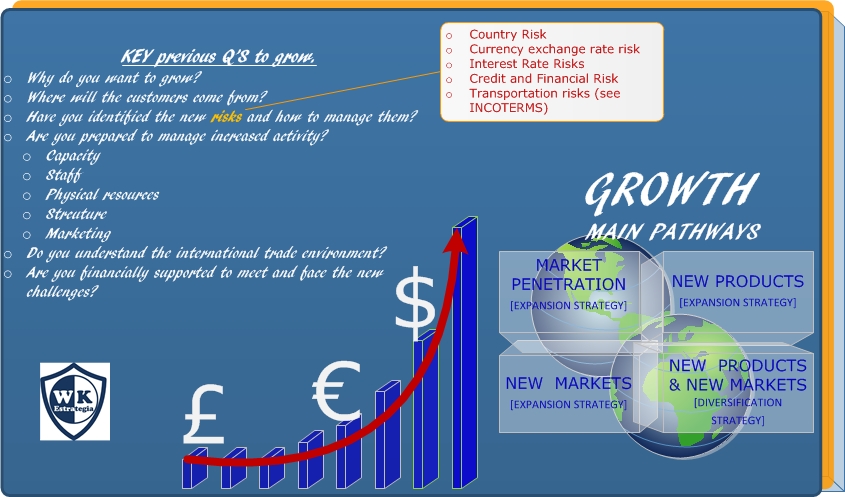
To gain properly commitment to achieve vision and mission goals from everybody involved in growth, it is important to communicate with effectiveness the organization's overall strategy to ensure everybody understands where the organization is and where is going. The growth project is a part of the overall strategy so growth objectives must be consistent with it.
General considerations:
- Goals and targets set must be SMART (Specific, measurable, Agreed upon, realistic and time bound).
- Growth strategies and tactics should have been thoroughly analyzed and have proper financial support.
- The expected –desired- return on investment (ROI) must be determined in order to lead to a situation in which consumer demand is being met and it is profitable for the company to meet that demand.
- Core elements of a business case are properly included: such as, overview of activity/initiative, including objectives, scope and key stakeholders; needs analysis; key assumptions; cost/benefit analysis; operational considerations; due diligence assessment (if athird partyis involved); risks indentified and mitigation strategies; timelines and reporting
- The most likely is that the business owner will have to change his role, and must be able to delegate responsibility to his assistants, those that have more appropriate skills to run the new business section or units. Also some adjustments in objectives of different key areas of the business and activities of the value chain, must be studied and if necessary accomplished.
The following challenges must be taken into account.
- Facilities and their limits (offices, communications, others)
- Cash flow being negatively affected
- Plant Capacity and its limits and ways to relieve excess of demand.
- Ways to seize identified economies of scope and scale.
- The managing staff and key employees should have time enough to deal with strategic matters and a probable administrative overload, along with level of impact in case of excess of demand in order to avoid a disruptive effect on relationships of key customers.
CONTACT:
If you need more information about what WK Estrategia can do to help you, please send us an e-mail to info@wkestrategia.es, or click on "contact" in lower side of this web site
 WK Strategy and Management
WK Strategy and Management








